THE AIRPORTS
NORTHERN CALIFORNIA
SAN FRANCISCO INTERNATIONAL AIRPORT
SFO
1970s
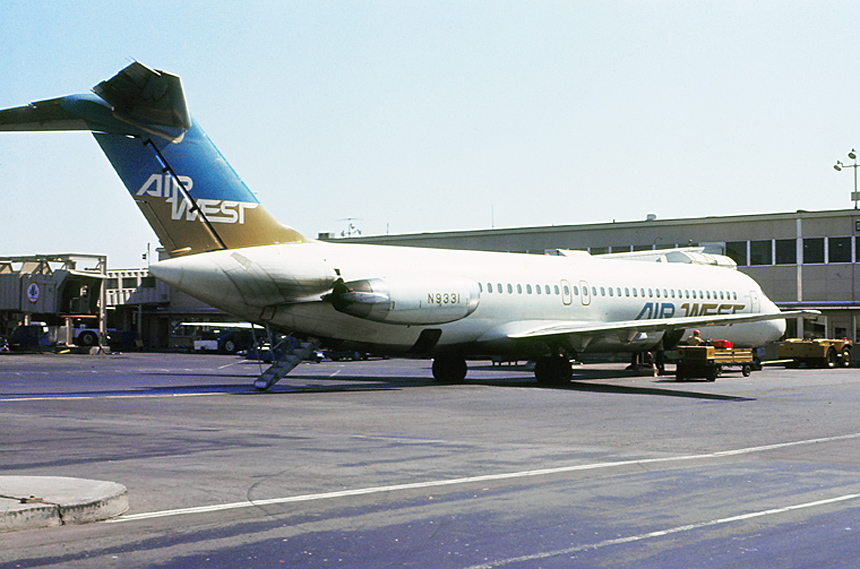
| April 1970 Air West continued to utilize its "jet" DC-9s for both major city pairs as well as smaller secondary routes from San Francisco including services to Eureka-Arcata, Fresno, Medford, and Eugene. Parked at the Central Terminal and awaiting passengers during a afternoon turnaround is N9331, a Douglas DC-9-31, originally destined for West Coast Airlines as N9106, but not taken up and delivered directly to Air West on June 4, 1968 right after the merger. |
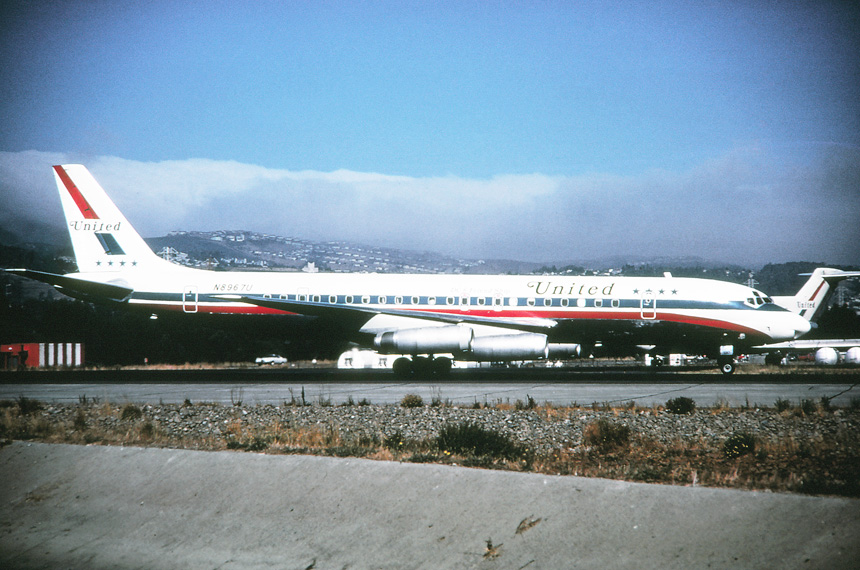
| June 1970 The Douglas DC-8 was the first commercial jet-powered airplane that would be introduced by the Douglas Corporation. United having been a loyal Douglas customer up to that point was part of the initial developmental process of the four-engined airliner with six-abreast seating. In 1955, Pan Am kick-started the DC-8 program with a order announcement simultaneous with the Boeing 707, followed by United announcement of thirty planes with deliveries starting in May 1959. United first DC-8 entered service on September 18, 1959 on a flight from San Francisco to New York City. As additional DC-8s were delivered to the airline they replaced the aging piston engine aircraft on mainline and transcontinental routings. Having taken Runway 1 Left for a mid-morning departure is N8967U, a Douglas DC-8-62H, delivered new to United in June 1969. |

|
September 1970 American Airlines was the first airline to start transcontinental commercial jet service in the United States with the introduction of the Boeing 707 on January 25, 1959. The first service was flown from Los Angeles to New York City. American soon replaced its multi-stop piston services with non-stop "Astrojet" services on transcontinental routes including flights from San Francisco to New York, Chicago, and Dallas Ft. Worth. Turning onto Runway 1 Left for a mid-morning departure is N7515A, a Boeing 707-123, delivered new to American on June 24, 1959. |

| January 1971 Trans World Airlines (TWA) was an early client of San Francisco and opened up a major maintenance base on airport property in 1961. Minor overhauls and "line" maintenance were performed for aircraft remaining overnight and to readying them for next morning service. When the "Superbay" hangar was built on the east side of the airport in 1972, both American Airlines and TWA would use the hangers carnivorous space to house their new 747 airplanes. Parked on the "line" during a foggy overnight check is N93105, a Boeing 747-131, delivered new to TWA in March 1970. |

| March 1971 Trans World Airlines (TWA) ordered eight of the legendary Boeing 707s in 1956, hoping to compete with Pan American Airlines and American Airlines in ushering in the "Jet" era. Due to continuing financial issues, TWA was only able to receive one 707 which was delivered in March 1959, and begun service a few months behind its arch aviation rivals. By the end of 1960, TWA had received fourteen Boeing 707s and the planes were placed on both domestic and international schedules. San Francisco was one of the first cities to see the new Boeing jets placed on non-stop services to Los Angeles, Chicago, and New York City. Eventually the Boeing 707 became the flagship aircraft for medium range domestic and international routings and by 1971, the airline was flying fourteen-nine (49) of the type throughout its extensive network. Taking the active Runway 01 Right for an afternoon departure is N6726, a Boeing 707-131B. |

| March 1971 United Airlines together with Lufthansa Airlines Germany were the launch customers for the Boeing 737 "twin-jet." The airline had initially ordered forty of the series-100, with the first entering service April 29, 1968. The airline used the smaller Boeing to replace the last of the Douglas DC-6 and Convair props on short and medium range routes across the nation. San Francisco saw the planes first used on regional flights to destinations such as Bakersfield, Fresno, Los Angeles, and Eugene and Medford, Oregon. Turning onto Runway 1 Right for a mid-day departure is N9055U "City of Midland/Bay City/Saginaw," a Boeing 737-222, delivered new to United in April 1969. |

| March 1971 Although Western Airlines had introduced jet airline service in June 1960, the Boeing 707 and subsequent Boeing 720 airplanes were too big for some of Western's markets. A solution came in the smaller, twin-engine Boeing 737 for which Western ordered thirty of the type with the first being delivered in June 1968. The size, performance, and operating economics of the 737 were perfect for many of Western's routes including regional flights from San Francisco to Las Vegas, Los Angeles, Ontario, and Portland. Parked at Gate 66 at the South Terminal during a morning turn-around is N4508W, a Boeing 737-247, delivered new to Western in August 1968. |

| April 1971 American Airlines hired Italian designer Massimo Vignelli in 1967 to create a new corporate image and logo for the growing carrier. Using patriotic colors, Helvetica script and the iconic double "A"s and stylized eagle, became a instant success for the airline. Agreeing to maintain a polished aluminum fuselage to lower weight due to painting, the new colors and logo were soon seen throughout the flight from airplanes to stationary, to timetables. Seen being pushed back from the gate for an early evening departure is N6821, a Boeing 727-223, delivered to the airline in December 1968. |
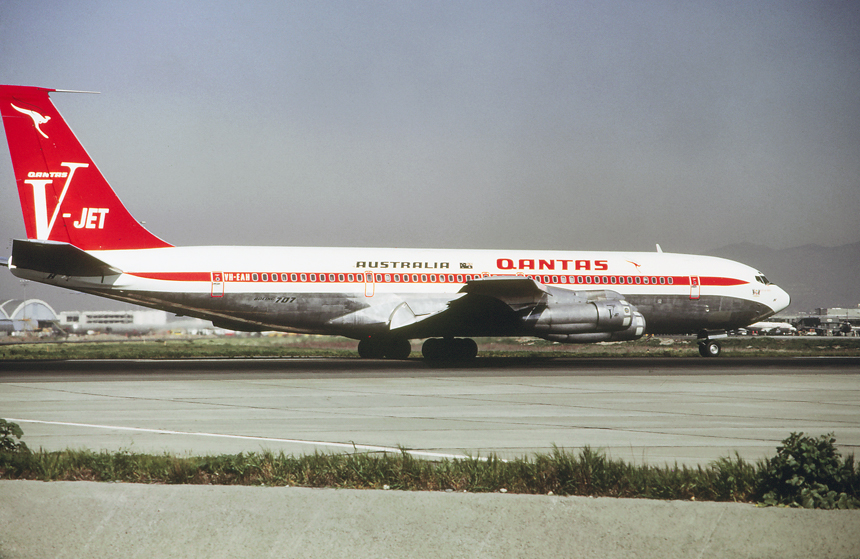
| April 1971 Queensland And Northern Territory Aerial Services (QANTAS) was an early international operator into San Francisco when a multi-stop flight was started in 1954 between Sydney, Australia and Vancouver, Canada via intermediate stops; Nadi, Fiji, Honolulu and San Francisco. QANTAS was an early operator of the Boeing 707 and the plane was used on the airlines first multi-stop, trans-Pacific Sydney to San Francisco jet flights which started on July 29, 1959. Holding in position on Runway 1 Right for an afternoon departure is VH-EAH, a Boeing 707-338C, delivered new to the airline on June 12, 1968. |

|
April 1971 Caledonian Airways was started in 1961, as a private, Scottish airline providing charter services from London Gatwick Airport to points in North America, Europe and the Far East. In 1970, Caledonian Airways was merged with British United Airways to become Caledonian/BUA and eventually British Caledonian Airways in September 1971. Caledonian had introduced seven Boeing 707-300 series on long range passenger and cargo charter and tour groups. San Francisco was a popular charter destination for holiday travelers seeking the warmth and culture of the charming West Coast city. Departing the South Terminal complex for an afternoon charter flight back home is G-AWTK, a Boeing 707-349C, originally delivered to Flying Tigers and purchased by Caledonian in December 1968. |
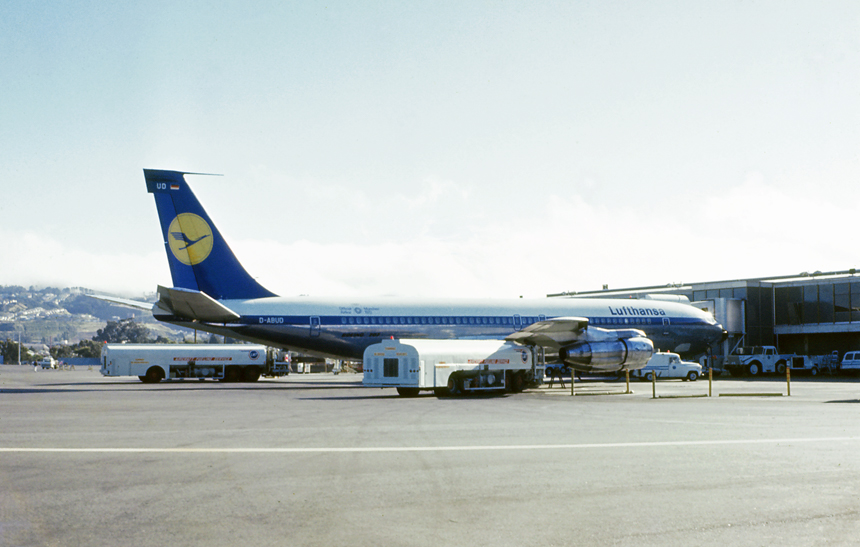
|
June 1971 German Airline Lufthansa had established itself as a formidable international airline flying routes from a Frankfurt, Germany base to points in Europe, North America, South America and the Far East. With introduction of the Boeing 707 "Intercontinental Jet," Lufthansa was able to expand service to the US West Coast. In May 1960, flights were started to San Francisco as an extension of the airline's Frankfurt-Paris-Montreal route, thus become the first European airline to start regular service to the Bay Area (BOAC started service to San Francisco in 1957, as a stop on its Round-the-World flight). Parked at the gate at the South Terminal and being prepared for an outbound flight is D-ABUD "Nurnberg," a Boeing 707-330B, delivered new to Lufthansa in November 1965. |
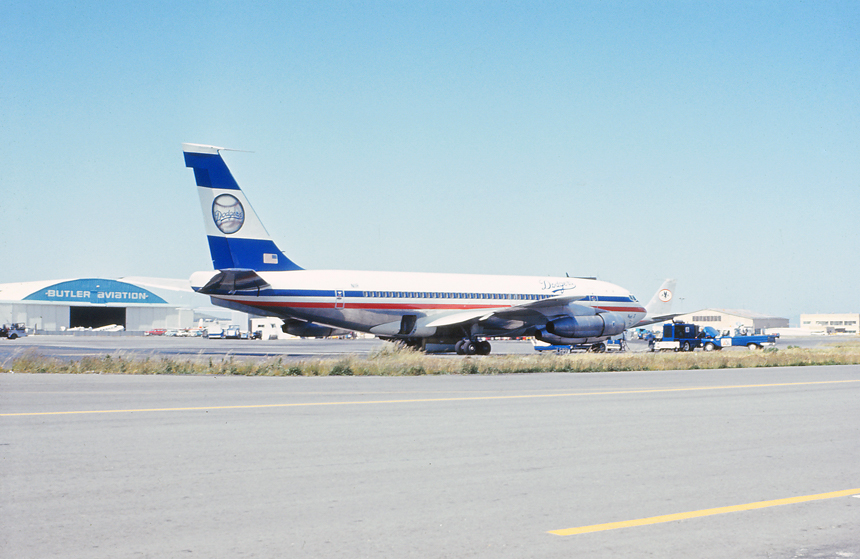
| June 1971 The Brooklyn Dodgers were the first team in MLB history to have an airplane for team travel. Dodger owner Walter O’Malley realized the speed and convince air travel had over traditional modes of travel by train or bus. O’Malley purchased a used Douglas DC-3 from Eastern Airlines and put the 20-seat "team" plane to use in 1949. The DC-3 flew for the team until 1957, when capacity issues required a larger airframe. In 1957, the Dodgers introduced a Convair 440, and after the move to Los Angeles later that year, O’Malley needed something larger. Over the next few years the team plane went from a Douglas DC-6 to a Lockheed Electra. Continuing to make history, the Dodgers placed into service their first "jet," a Boeing 720B in 1971. Named “Kay-O II," after the owner’s wife, the Dodgers 720 was seen across the US transporting the team to ballparks nationwide. With growing maintenance costs and a change in ownership the Dodgers team plane was finally retired on April 1, 1983. Parked at San Francisco International Airport as the team plays the Giants at neighboring Candlestick Park is N1R, a Boeing 720-023 originally delivered to American Airlines in December 1960, and purchased by the Dodgers organization in January 1971. |
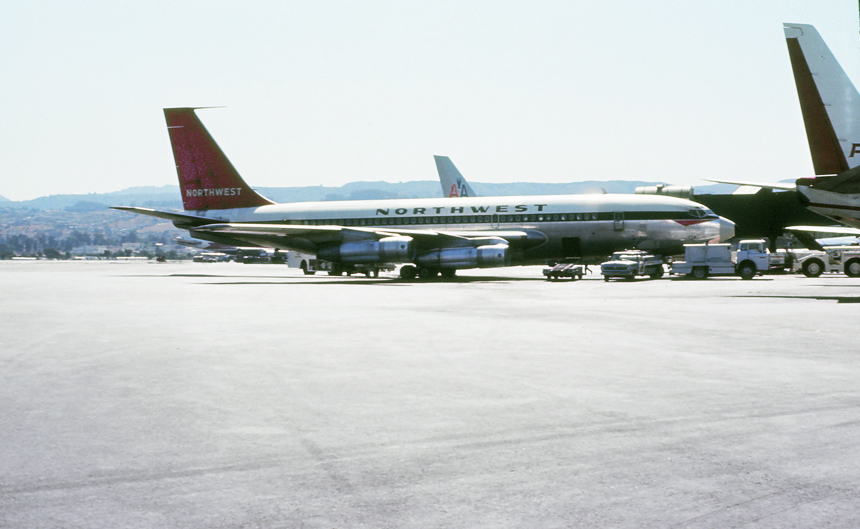
| June 1971
Northwest Airlines was based at Minneapolis-St. Paul and initially evolved around a route structure that as its name suggested, was focused within the "Northwest." Early flights connected Minneapolis to Seattle via a multi-stop route across the northern and northwestern portion of the United States. Looking to expand into the California and Hawaii markets (The airline was already serving the Seattle/Portland-Hawaii routes), Northwest applied to serve Japan from California in 1968. As part of the Civil Aeronautics Board (CAB) 1969, Pacific Route Case, Northwest Airlines was awarded routes from both San Francisco and Los Angeles to Tokyo, Japan via Honolulu, Hawaii. Flights from San Francisco were started on August 1, 1969, using the Boeing 720 "Fan Jet" and establishing a foothold into a major market the airline had desired for years. Parked at the gate and being serviced for another flight is N734US, a Boeing 720-051B, delivered to Northwest Airlines in October 1963. |

| July 1971 Trans World Airlines (TWA) was under the direction of Howard Hughes when the eccentric billionaire took a rather unorthodox step and ordered thirty Convair 880 airliners in 1956. Convair was a reputable manufacture of military and short range piston aircraft when it decided to jump into the commercial jet aircraft market. Due to financial difficulties in the late 1950s, TWA's first jet Convair didn't enter service until January 12, 1961. Although only configured for 85 passengers, the Convair 880 had an impressive display of speed, with a typical cruise of 610 miles-per-hour. In fact the title "880" derived from the cruising speed when configured to feet-per-second. Although San Francisco didn't initially host the Convair 880, the plane was eventually rotated into the network and was eventually used on the San Francisco-St. Louis and San Francisco-Chicago routes. Awaiting take-off clearance on Runway 01 Right is N826TW, a Convair 880 M22-1 "Star Stream." |

| July 1971 When four California commuter were merged to form Golden West Airlines in 1969, Sacramento based Skymark Airlines was the only carrier that had provided service to Northern California. Golden West assumed the routes out of the small San Francisco hub, which was providing commuter flights to Santa Rosa, Monterey and San Jose using the de Havilland DHC-6 Twin Otters. Within just a few years it was realized that operating such a large area in California was causing a financial drain to the new airline and in 1973, the Northern California routes and operations were sold to local commuter STOL Air. Preparing to depart that ramp at the Central Terminal for another regional flight is N6387, a de Havilland DHC-6-100 Twin Otter. |
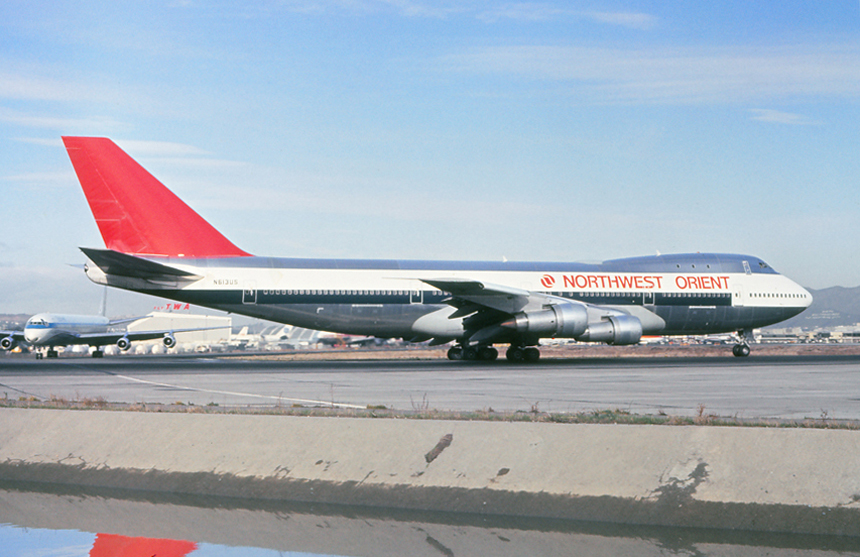
|
September 1971 As with almost all of the major airlines in the 1960s, Northwest Airlines ordered the Boeing 747 to better serve various trans-Pacific and Orient routes that the airline continued to add to its network. The first, 369-passenger Boeing 747 was delivered to Northwest in April 1970 and was initially placed on the Minneapolis-St. Paul to New York services. Within a few months the Boeing 747 was placed on flights between both Los Angeles and San Francisco to Honolulu and became the first airline to place the Jumbo on trans-Pacific services. At the same time the new Boeing 747s were delivered, Northwest introduced a new corporate image including adding the word "Orient" to its title reflecting the growing presence the airline had in the Far East. Awaiting takeoff clearance on Runway 01 Right is N613US, a Boeing 747-251B which was delivered just a few months earlier in June 1971. |
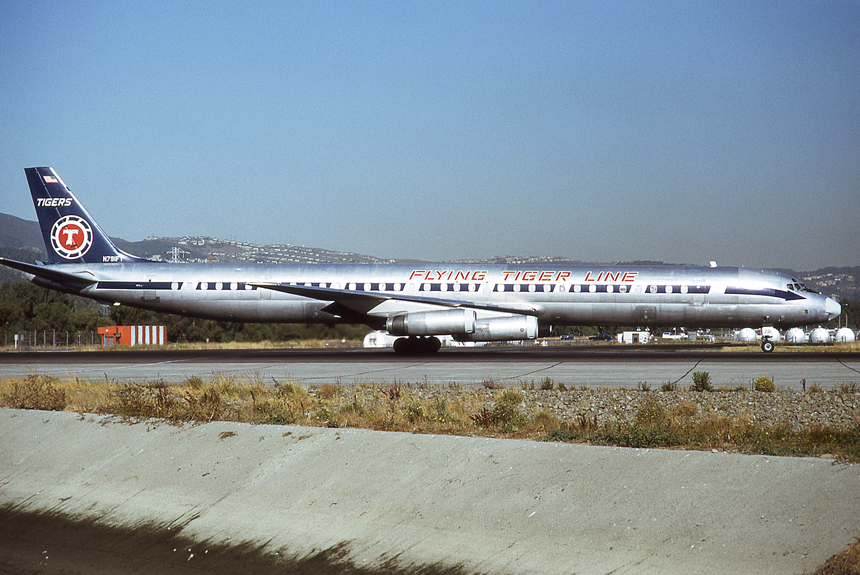
|
September 1971 With Flying Tigers being the largest cargo airline in the world, the carrier was an early operator of the "freighter" version of the new jet airplane market, bringing the speed and efficiency of the new "jets" to the cargo industry. The airline initially ordered four Boeing 707s in 1965, however the plane was soon replaced with the higher capacity Douglas DC-8. The airlines first all freighter Douglas DC-8-63F was delivered on June 26, 1968 and was one of nineteen operated by the airline. The DC-8 was used on the major routes intercontinental routes flown by the airline, mainly on services between San Francisco, Los Angeles, Chicago and Boston. Holding in position for takeoff on Runway 1 Left for an afternoon departure is N791FT, a Douglas DC-8-63CF, delivered new to the airlines on March 17, 1969. |
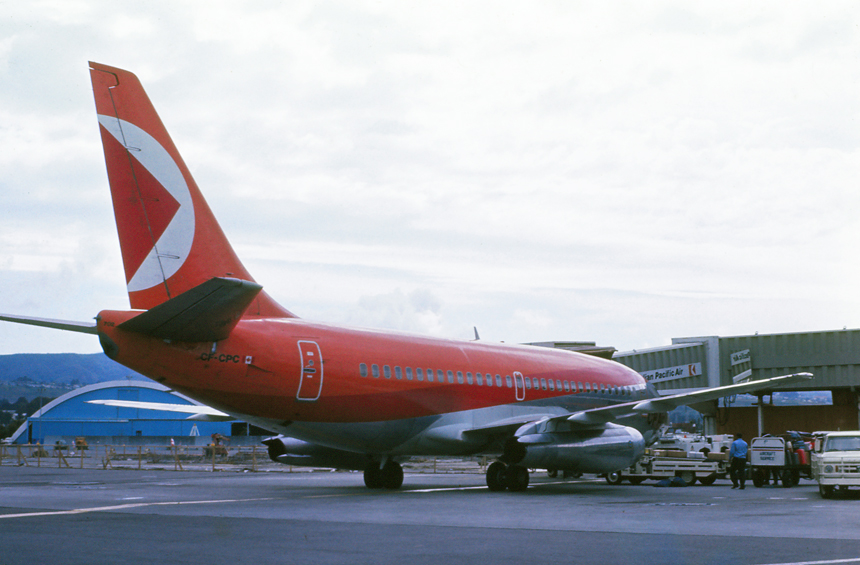
| October 1971 Canadian Pacific Airlines was the second largest carrier to provided passenger service in Canada, however was left to initially fly unpopular domestic and international routes that government owned airline Air Canada dismissed. San Francisco was added to the network in 1967, with a daily, non-stop flight to Vancouver using the Douglas DC-8. After a name change to CP Air in 1968, and delivery of new Boeing 737s, San Francisco service was provided by the baby Boeing on its sole US service. CP Air continued to serve San Francisco well into the 1980s. Parked at the gate at the International Terminal is CF-CPC, a Boeing 737-217, delivered new to CP Air on October 11, 1968. |
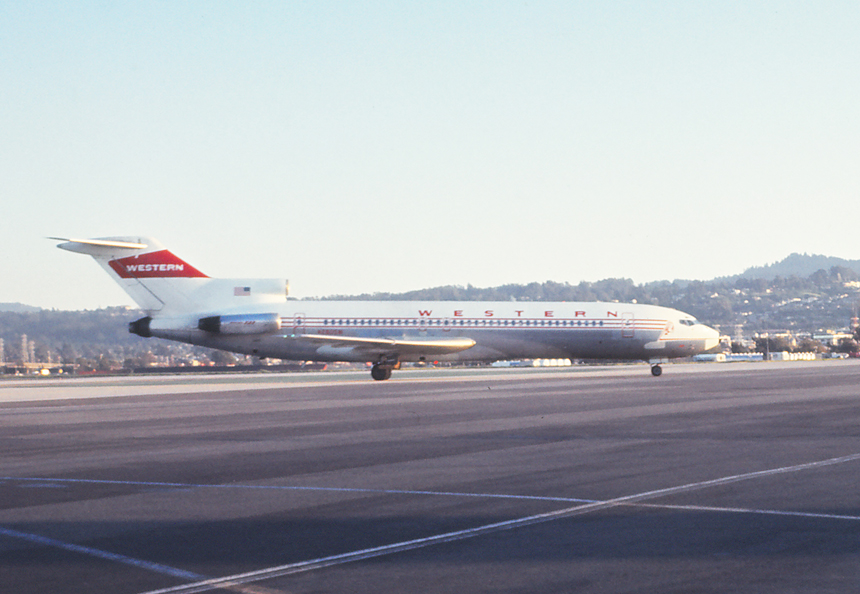
| November
1971 Western Airlines placed an order for the "stretch" version of the successful Boeing 727 in 1969, to supplement the existing fleet of Boeing 707 and 737 aircraft. The new series-200 planes would be placed on short to medium range trunk routes in the Western network and with a passenger capacity of 135-passengers would increase capacity in some markets. San Francisco was an early host to the airlines Boeing 727 and was initially placed on services from the airport to both Los Angeles and Vancouver, Canada. Taxiing inbound toward the gate on a pleasant fall evening and wearing the classic "Indian head" color scheme is N2805W, a Boeing 727-247, delivered new to Western Airlines on October 29, 1969. |
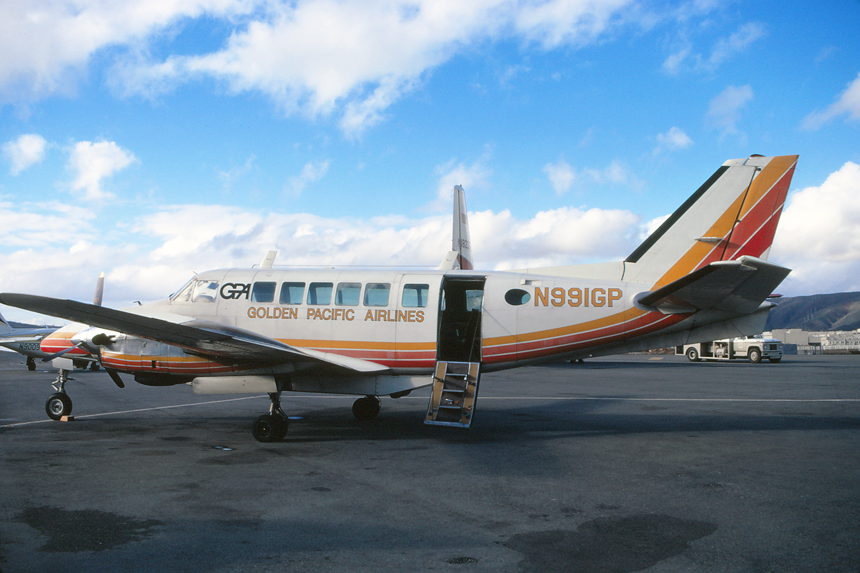
| February 1972 Golden Pacific Airlines which started services in 1969, was one of the first commuters established in Northern California. Based at San Francisco International Airport, the airline flew the "new" Beechcraft 99 turboprops to numerous destinations across the northern part of the state. With rapid expansion operating costs became high resulting in the airline eventually filing bankruptcy in 1973. Parked on the ramp and awaiting passengers is N991GP, a Beech 99, delivered new to Golden Pacific in June 1969. |

| April 1972 United Airlines took delivery of its first Boeing 747 "Jumbo Jet" on June 30, 1970. The airline dubbed its new 747s, "Friend Ships" and were first placed into service in late August flying the popular route between both San Francisco and Los Angeles to Honolulu, Hawaii. As more 747s were delivered over the subsequent months, United introduced the plane on heavy domestic routes, specifically Chicago to Los Angeles and Chicago to San Francisco followed by introduction of non-stop Chicago to Honolulu services. Seen preparing to depart on Runway 01 Right for a mid-day flight is N4720U, a Boeing 747-122 delivered new to the airline in July 1971. |

| April 1972 Taipei, Taiwan based China Airlines acquired two Boeing 707 aircraft and inaugurated trans-Pacific services to San Francisco to Taipei via Tokyo and Anchorage in 1970. After a few years, flights were routed through Honolulu or Anchorage then Tokyo and on to Taipei on a thrice-weekly service. The direct service became popular as on of the early links to the growing trade and business markets of Taiwan. Parked at the terminal and being serviced for another westbound flight is B-1824, a Boeing 707-309C, delivered new to the airline on November 7, 1969. |
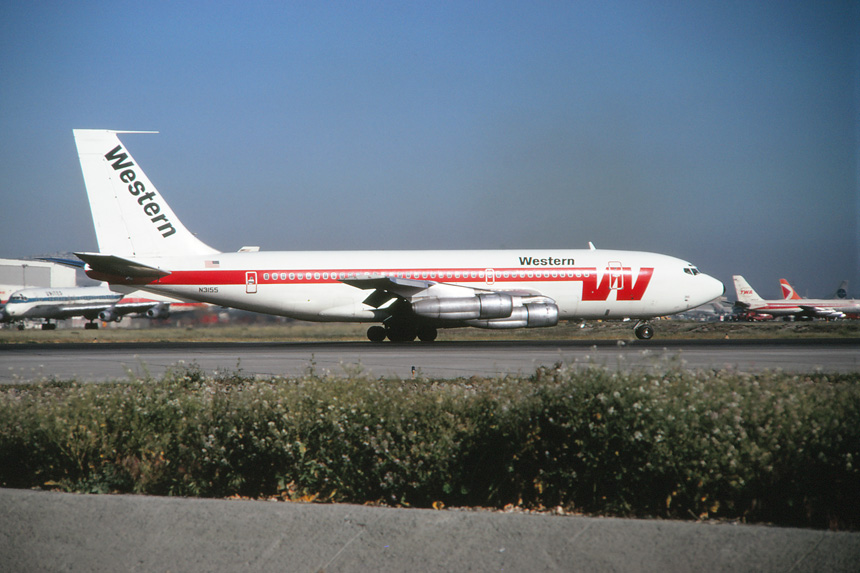
| May 1972 Western Airlines ordered its first long-range jet aircraft, the Boeing 720, in February 1960, to better compete with national carriers such as United on medium-range, regional routes. Although the first deliveries of the new 720 weren't scheduled until 1961, Western ran into trouble when its fleet of Electra Turboprops were grounded. In an effort to "jump-start" jet service, Western leased two Boeing 707 airplanes, originally destined for Cuban national airline Cubana in May of 1960 on the popular Los Angeles-San Francisco-Portland-Seattle route. The first of three ordered Boeing 720 aircraft was placed in service on May 15, 1961 between Los Angeles and Mexico City. During the 1970s, Western used the Boeing 720 on trunk route services from San Francisco to Honolulu, Minneapolis, Denver, Seattle, and Los Angeles as well as international service to Mexico City. Starting its takeoff roll on Runway 1 Left is N3155, a Boeing 720-047B, delivered new to the airline on May 19, 1965. |
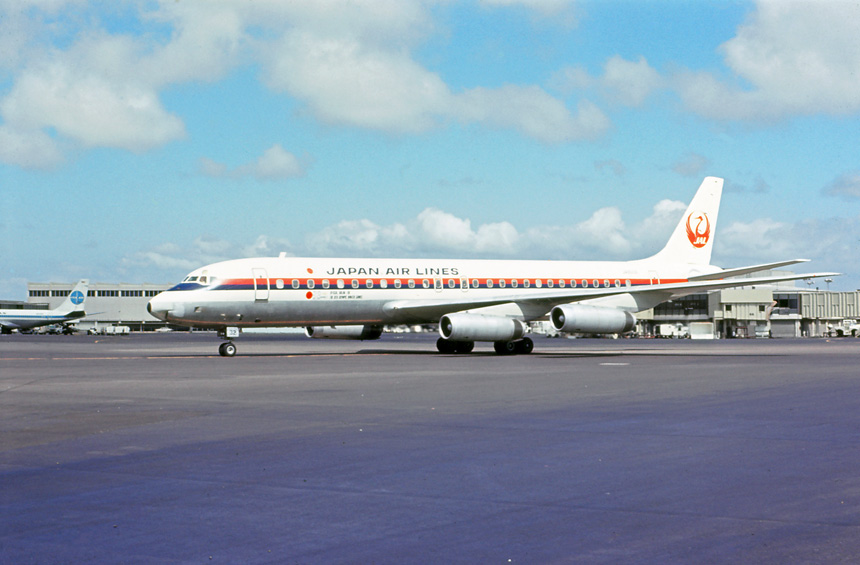
| May 1972 Taxiing inbound to the international ramp is JA8032 "Hidaka," a Douglas DC-8-62. Interestingly, this aircraft having been delivered in May 1968, was involved in a landing accident at San Francisco only four months later. On November 22, 1968 while on approach during foggy conditions after a flight from Honolulu, the DC-8 landed short of the airport in the shallow bay. The plane settled down in ten feet of water and no injures were reported as passengers evacuated by raft. The plane was removed and refurbished by United Airlines and three months later was returned to service and continued to fly for JAL until 1983. |

| May
1972 During the 1960s, many of the major national airlines established a cargo only division of the airline, catering to freight shipments and actually converting existing planes or ordering pure freighter aircraft for this service. United Airlines had an extensive freight airline network and inaugurated service between Chicago, San Francisco and Los Angeles in March 1964. United eventually operated a fleet of fifteen Douglas DC-8 "Jet Traders" all being delivered new to the airline. San Francisco was considered a regional freight hub and into the 1970s, had flights to seven cities including, Detroit, Honolulu, Los Angeles, New York-JFK and Portland, Oregon. With the deregulation of the air cargo industry in 1978, and entry of non-airline based freight companies into the market, United withdrew from the air cargo industry by the early 1980s. Holding in position for takeoff on Runway 01 Right for an afternoon departure is N8044U, a Douglas DC-8-54AF, delivered new to United Airlines on September 10, 1965. |

| June 1972 In the era of “Bigger-is-Better," Pan American Airways launched the wide-body revolution when Boeing 747 service was started between New York-JFK and London Heathrow. The new “Queen of the Skies” was meant for both intercontinental and heavy transcontinental services and each of the major airlines were quick on the heels of Pan American to start its own “wide-body” services. TWA, American and United all started services between the Northeast and California by summer 1970. This was followed by other legacy carriers; Continental, Northwest Orient, Braniff, and Eastern. Not to be missed and fresh with approval from the Civil Aeronautics Board (CAB) on the Southern Transcontinental Route case, Delta Airlines ordered five of the Boeing 747 airplanes for transcontinental services. With the first plane delivered in the trademark “Widget” in September 1970, services were inaugurated on an Atlanta-Dallas-Los Angeles route on October 25, 1970. As additional 747s were delivered, the 370-seat wide-body was placed on Atlanta-San Francisco and Dallas-San Francisco services in early 1971. As with many of the airlines, Delta soon realized that in order to operate the 747 cost effectively, they needed large, consistent volumes of traffic and the transcontinental routes just couldn’t support the increasing costs of the 747. After careful consideration and evaluation, it was decided that the 747 was not economical for the Delta route profiles and the last plane was removed from service in April 1977. Delta eventually replaced the Boeing 747 with a new entrant into the wide-body community, the Lockheed L-1011, which was first delivered to the airline 1973. Taking Runway 01 Right for a mid-day departure in June 1972, and looking smart in the classic Delta colors is N9898, a Boeing 747-132, originally delivered to the airline in November 18, 1970. |

| July 1972 Inspired by tradition and culture, the famous Japan Airlines "crane" logo was actually designed by an American advertisement firm which had been hired by JAL since its early days of operation. Representing strength and loyalty, the crane symbol was also a tribute to the historic Samurai family crests. The logo was officially introduced in 1959, however as a small representation behind the cockpit windows with the 1960s era color scheme. With the introduction of the Boeing 747 in April 1970, JAL introduced new corporate colors using the crane as the main symbol on an all white tail. Over a few years existing aircraft were repainted to reflect the new image and carry the Japanese sprit world-wide. Seen holding in position on Runway 01 Right for a non-stop flight home is JA8011 "Towada," a Douglas DC-8-53. |
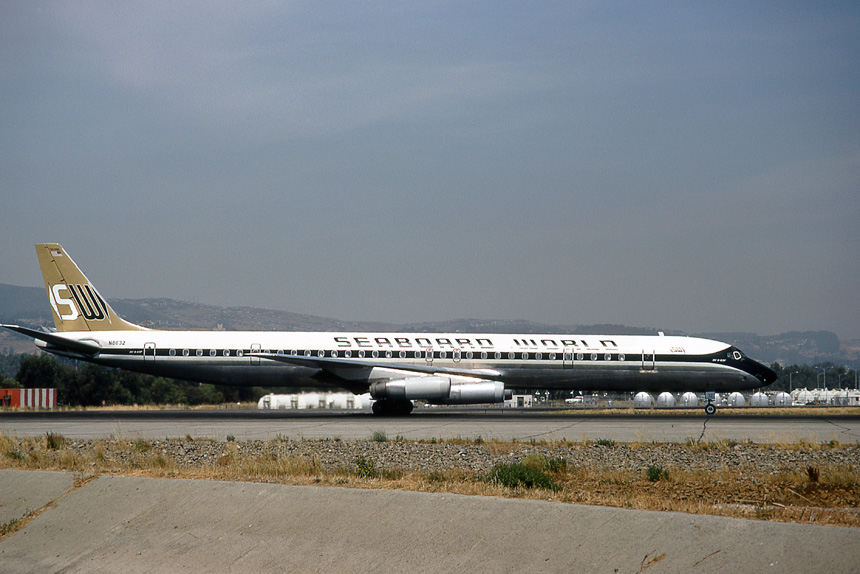
| July 1972 One of the few all-cargo airlines to start operations after World War II using surplus Douglas DC-4 freighters was Seaboard & Western Airlines. The name was a bit curious and was derived from the fact that the airline sought service between the Eastern Seaboard of the US and Western Europe. With cargo flights starting in May 1947, the airline grew into a formidable contract cargo and eventual charter passenger airline. Lockheed Constellations joined the fleet in 1954 and increased the cargo carrying capacity of the old DC-4 by a factor of four. Considering the charter airline was continuing to grow and was serving points now worldwide, the name of the airline was changed to Seaboard World Airlines in April 1961. The first jet aircraft for Seaboard, a Douglas DC-8 arrived from Douglas in June 1964, and the airline was so happy with its initial success that the airline was the lead customer of the “stretch” Douglas DC-8-63CF, or “Convertible Freighter” version. The new DC-8-63CF, gave Seaboard the option of either flying passengers or cargo as customers required and with new military contracts, the DC-8-63 gave the airline tremendous flexibility. Seaboard World was leading the industry as a primer global contract carrier and even became the first to order and operate the Boeing 747 Freighter aircraft in 1974. On the heels of deregulation of the air cargo industry in 1978, a decision was made to merge Seaboard World into The Flying Tiger line in October 1980. Holding in position for takeoff on Runway 1 Left for an afternoon cargo charter flight at San Francisco International Airport is N8632, a Douglas DC-8-63, delivered new to Seaboard World on September 16, 1968. |

| August 1972 American Airlines together with United Airlines and Eastern Airlines worked with Boeing in the early 1960s to develop an aircraft that could be economical on short and medium range flights and be able to operate within smaller airports located nearer city centers (LaGuardia, Washington National). The three-engine, narrow-bodied Boeing 727 was born and was introduced into service by American Airlines in April 1964. American would acquire both the series-100 and -200, eventually operating 184 Boeing 727s, thus becoming the largest operator of the type world-wide. American introduced the 727 on San Francisco service in the late 1960s and by the 1970s, the plane was being used on medium-range flights from SFO to Dallas-Ft. Worth, Oklahoma City, and Phoenix. Having just lined up on Runway 01 Right for a morning departure is N6842, a Boeing 727-2A7 "Astrojet," originally delivered to Trans-Caribbean Airlines in May 1969, which was than subsequently purchased by American Airlines in 1971. |

| August 1972 United Air Lines was the launch customer for the Boeing 707, derivative known as the Boeing 720. The new airplane was a higher-performance, short-to-medium range variant of its parent with resigned wings and more efficient engines. United Air Lines placed the plane into service on July 5, 1960, on a Los Angeles-Chicago service via Denver. The airline eventually operated twenty-nine of the Boeing 720 airframes and we used to supplement the domestic 707 and Boeing 727. Awaiting takeoff clearance on Runway 1 Right is N7203U, a Boeing 720-022, delivered new to United Airlines on April 30, 1960. |

|
September 1972 Pan American Airways started service into San Francisco (Alameda Airport) in 1935, as the west coast terminus of their famed China Clipper service. Eventually flights migrated over to the new San Francisco Municipal Airport just south of the city in the 1940s. Trans-Pacific service to Honolulu remained, with flights continuing on to Fiji, Tokyo or Manila. By 1960, Pan Am had started non-stop flights from San Francisco to London, England using the Boeing 707 and had added domestic flights to both Los Angeles and Portland. As one of the launch customers for the double-decker Boeing 747 "Jumbo Jet," Pan Am was instrumental in the initial design and development of the plane. Pan Am ordered twenty-five of the 747s in August 1966 at a cost of $525 million, the most expensive order ever placed for an aircraft at that time. The airline took delivery of its first Boeing 747 on January 15, 1970, and was placed into service a few weeks later on January 22 on the prestigious New York-London route. San Francisco started to see the Pan Am Jumbo's in 1971 when new non-stop service to Tokyo, Japan was inaugurated. Taking Runway 01 Right for an early evening departure is N737PA "Clipper Red Jacket," a Boeing 747-121, delivered to Pan Am on January 9, 1970. |

|
September 1972 Pacific Southwest Airlines (PSA) made a historic announcement in 1964, when it placed an order for six of the new Boeing 727 jet airliners for $25.6 million. This step in the "right" direction was instrumental in pushing PSA from its local intrastate reputation to one that would be able to compete with the "big boys." The new 128-seat Boeing Trijet, would increase capacity and speed on the company's most popular route; the infamous Los Angeles-San Francisco corridor flights. PSA received its first Boeing 727-100 jet on April 9, 1965 and within a few weeks supplemented Lockheed Electra services on the Los Angeles-San Francisco flights. As additional 727s were received, the plane was placed on the San Diego-San Francisco flights with an unbelievable one-way fare of $13.50. This low price prompted a fare war between both United Airlines, TWA and Western Airlines with the Civil Aeronautics Board (CAB) finally having to mediate. With the introduction of new planes and "jet" service, PSA also took the opportunity to restyle it's flight attendants with new uniforms. By the end of 1965, PSA had five Boeing 727s in it's fleet and started a relationship with the trusty Boeing that would last into the early 1980s. Rolling for takeoff on Runway 01 Right is N975PS, a Boeing 727-14, delivered new to PSA on March 7, 1966. |

| September 1972 During the early 1970s, many of the majors had their own all cargo divisions of the airline and a few Boeing 707 and Douglas DC-8 "freighters" were acquired for this service. Trans World Airlines (TWA) had a fleet of all-cargo Boeing 707s used for nightly cargo service across the United States. San Francisco was a major west coast cargo hub and saw TWA "Cargo Jet" flights nightly. TWA Flight 604 was the nightly, non-stop cargo run to New York-JFK Airport and during its takeoff run from Runway 1 Right the crew of three noticed a severe vibration just past V1. Rather then commit for takeoff, the crew elected to abort the takeoff and applied the brakes, thrust reversers and spoilers. However at approximately 2243 that evening, the aircraft overran the runway and ended up in San Francisco Bay. All three crew members survived and were found on top of the cockpit, the aircraft however was substantially damaged and was eventually written off. After investigation it was found that the vibration was the result of failure of two right rear truck tires resulting in vibration and deceleration. The cause of the accident was attributed to initiation of rejected takeoff procedures beyond V1 with insufficient runway remaining to stop the aircraft. It is interesting to note, that during the subsequent accident investigation in the "Super Bay" hanger at San Francisco, guns being smuggled to the IRA were found in the cargo, which prompted involvement by the FBI. Seen on September 13, 1972,"resting" in San Francisco Bay just off the departure end of Runway 01 Right is N15712, a Boeing 707-331C. |

| October 1972 During the turn of the 1970s Western Airlines had suffered some financial woes and had flirted with the prospect of a merger with American Airlines. By early 1970, the merger had been cancelled, reorganization was underway and to take the airline into the 1970s, Western initiated a "new look," including an updated color scheme. The classic "Indian head" colors were replaced with a stylized W with bold Western titles on a white fuselage. Quickly to become known as the "Swizzle-stick" or "Winnebago" logo, the entire fleet started to be repainted in August 1970. Additionally, marketing strategies were re-evaluated and new interiors and in-service perks were added including the introduction of the famed all-passenger complimentary "Champaign" service. Lining up on Runway 01 Right for an afternoon departure is N2810W, a Boeing 727-247, delivered new to Western Airlines just two months earlier on August 4, 1972. |

| November
1972 Northwest Airlines ordered eleven of the Boeing 727-100 "Tri-jets" in 1964, to fill the need for a short to medium range airliner. Northwest ordered the "Combi" version of the plane with a left side main deck cargo door for mixed cargo/passenger flights as needed. The first 727 was delivered in 1964, and replaced both the Lockheed Electra and Douglas DC-7B on domestic services. After approval was finally given, flights were started from Minneapolis-St. Paul to San Francisco on October 1, 1969. The Boeing 727 was placed on the new services to Minneapolis supplementing the Boeing 720 and becoming popular for connections in the northeast. Taxiing away from the terminal for an evening departure is N499US, a Boeing 727-51C delivered to the airline in May 1967. |

| February 1973 American Airlines initiated a study of an airliner that could carry 250 passengers in "wide-body" comfort, have a range between 1500-2000 miles and be able to utilize existing airports and runways. Boeing, Lockheed and Douglas all designed proposals for a medium-range, wide-body aircraft to serve airlines into the 1970s and beyond. Douglas presented the DC-10, a "tri-jet" design, with the additional third engine necessary to guarantee performance from shorter runway airports like New York-La Guardia. American Airlines was one of the launch customers of the new plane with an order for fifty planes (25 ordered with 25 options). The first DC-10 was delivered on July 29, 1971, with inaugural flights starting a week later. San Francisco saw the DC-10 a few weeks later when the plane was introduced on non-stop flights to both Chicago and New York-JFK. Awaiting take-off clearance on Runway 01 Right is N101AA, a Douglas DC-10-10. |
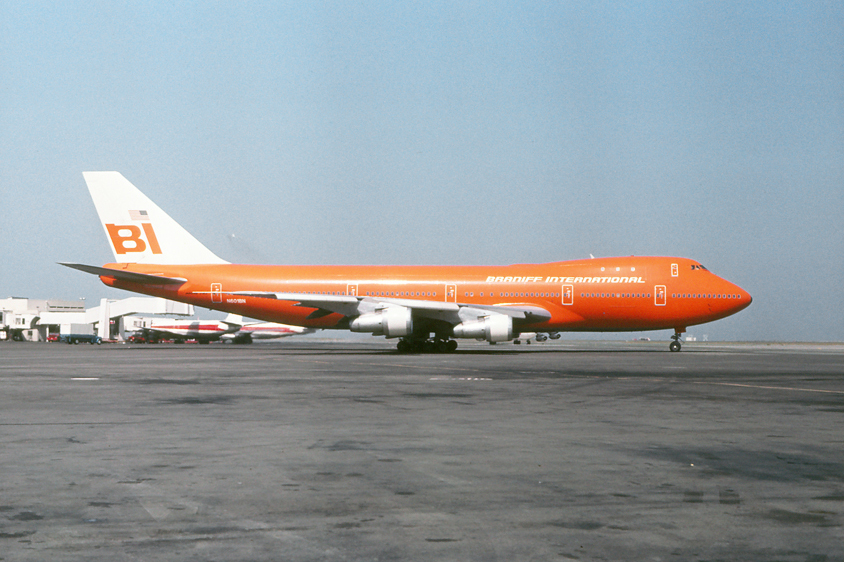
| March 1973 Braniff International Airlines started regular service into San Francisco in 1974, as an extension of its Lima, Peru to Los Angeles route using the Douglas DC-8. The published, thrice-weekly route was a one-stop flight to Lima with Los Angeles serving as the en-route stop with no de-boarding privileges to San Francisco passengers. A year earlier however, Braniff arrived at San Francisco in a special flight using its legendary "Big Orange" Boeing 747. Braniff's first Boeing 747 was delivered in January 1971, and painted in a striking orange color scheme, typical of Braniff's popular image. The new plane officially known as "747 Braniff Place" was used on the company's Dallas to Honolulu flights. In March 1973, the Military Air Command (MAC) requested additional civil capacity to bring home the last remaining troops in South Vietnam. Braniff offered its Boeing 747 and the subsequent flight was known as the "Freedom Bird" and took 356 troops from Saigon, South Vietnam to San Francisco via Guam and Honolulu. The home-bound troops arrived at San Francisco late in the evening on March 28 to a heart-felt reception at the terminal. Taxiing away from the terminal for a ferry flight back to Dallas to be put back into revenue service having completed its service to the country is N601BN, a Boeing 747-127, Braniff Airlines first and the 100th Boeing 747 off the assembly line. |
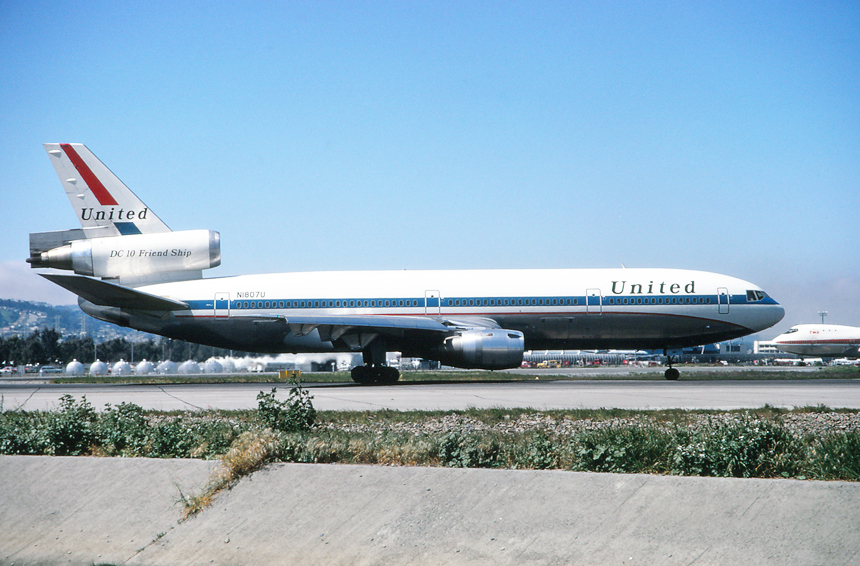
| April 1973 United Airlines was one of the launch customers of the Douglas DC-10, along with American Airlines and ordered sixty (60) of the type in 1968. United received its first DC-10 wide-body on July 31, 1971, and the airplane inaugurated passenger service on August 14, 1971, from San Francisco to Washington D.C. (Dulles). The DC-10s were soon placed on other transcontinental services from San Francisco as well as flights to Hawaii. Starting its take-off roll on Runway 01 Right is N1807U, a Douglas DC-10-10, delivered new to United Airlines on December 20, 1971. |
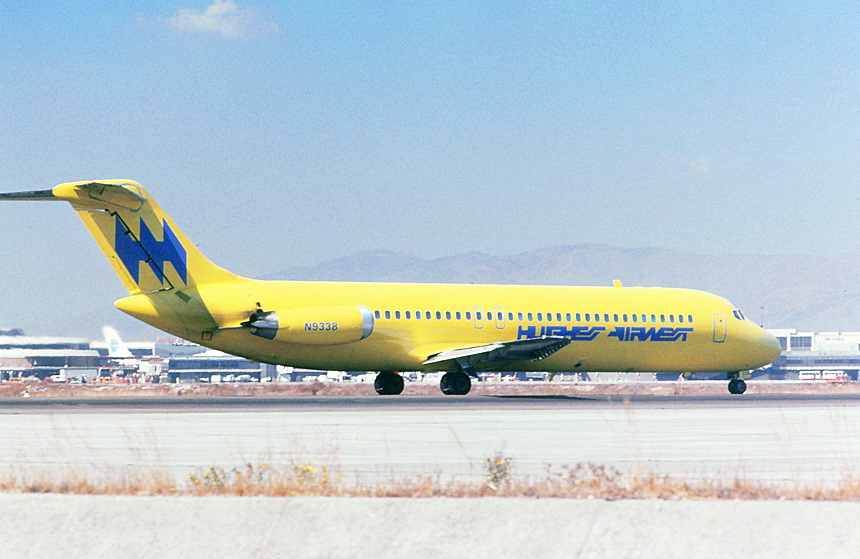
| May 1973 Following a lineage that dated back to predecessor Southwest Airways in 1941, Hughes Airwest was the result of mergers and name changes over some 30 years. Southwest Airways would become Pacific Airlines in 1958 and then merge with both Bonanza Airlines and West Coast Airlines to form Air West in April 1968. Eccentric billionaire Howard Hughes purchased Air West in 1970, and rebranded the airline "Hughes Airwest" with a striking new yellow and blue color scheme in 1971. San Francisco remained an important hub for the airline and no less then 35 daily flights to numerous regional destinations including Eugene and Portland, Oregon, Chico, Lake Tahoe, Sacramento, Los Angeles and Eureka, California were flown using both Douglas DC-9 and Fokker F-27 aircraft. Seen rolling for take-off on Runway 01 Right in the vibrant "Yellow Banana" colors is N9338, a Douglas DC-9-31. |

| May 1973 Western Airlines was an early operator into San Francisco when service was started in 1944, from Los Angeles. The airline would expand at the airport eventual adding flights to both Portland, Oregon and Seattle, Washington in the 1950s using Douglas DC-4s. Western took delivery of its first Boeing 737 in June 1968 and the new planes were used on regional services throughout the route network. San Francisco was connected to numerous regional destinations including Los Angeles, Reno, Ontario, Las Vegas and Portland with the Boeing 737. Awaiting takeoff clearance on Runway 01 Right is N4513W, a Boeing 737-247, delivered to the airline in October 1968. |
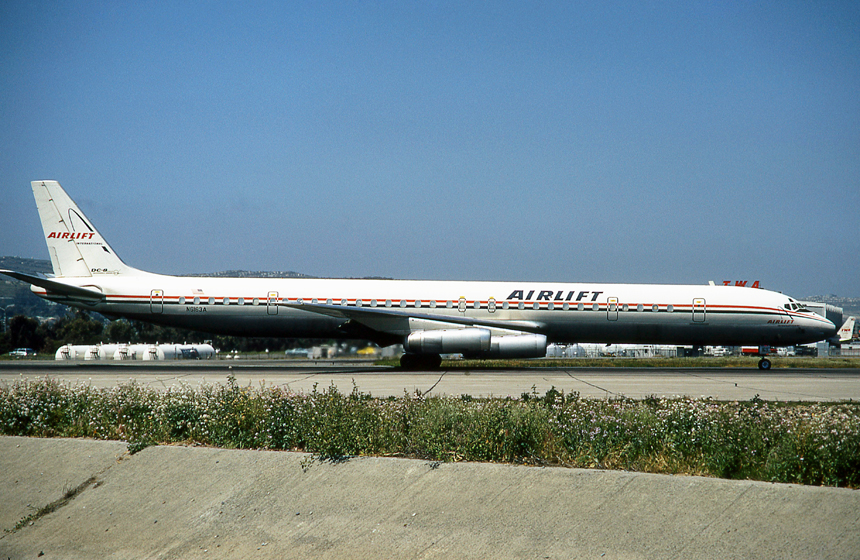
| August 1973 Founded originally as Riddle Airlines in 1945, a name change twenty years later saw the airline become Airlift International. Based in Miami, Florida, the airline focused it's efforts on both contract freight and charter services. Scheduled freight service started in the 1960s, and San Francisco saw the use of the "jet freighters" as a final stop on the airlines Miami-Houston-Dallas-Los Angeles-San Francisco service. Using a mixed fleet of Boeing 727, 707, and Douglas DC-8 aircraft, the airline provided both scheduled cargo service and contract cargo flights on a world-wide basis. Awaiting takeoff clearance on Runway 01 Right for an early evening departure is N6163A, a Douglas DC-8-61CF, originally delivered to Airlift International on September 15, 1969. |
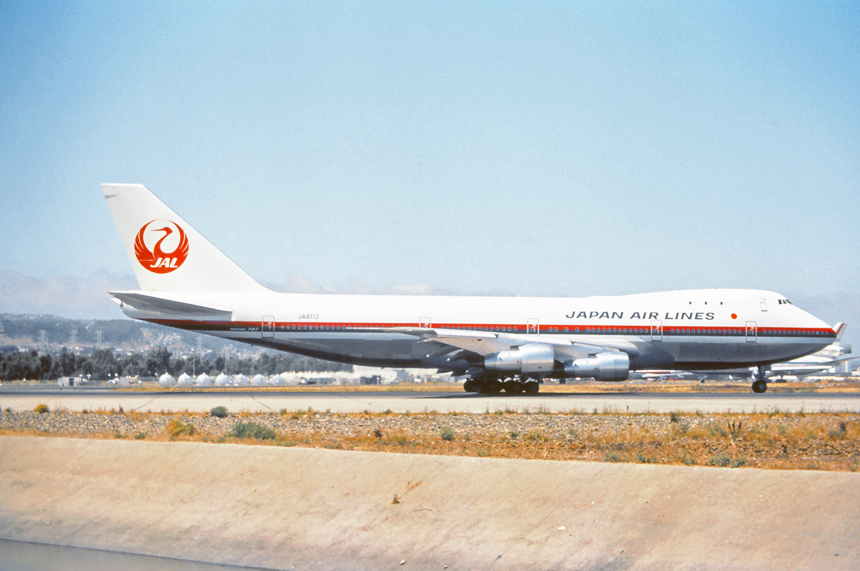
|
September 1973 Although pleased with the performance and characteristics of the Douglas DC-8, Japan Airlines (JAL) was quickly interested in the new Boeing "Jumbo Jet" and saw the new plane as an answer to capacity and range considerations. In 1966, JAL placed faith in the proposed "mega-liner" and secured an order for the 747 becoming only the second airline world-wide to do so. JAL received its first Boeing 707-100 on April 22, 1970, and the plane was soon placed on the popular Tokyo-Honolulu-Los Angeles routing. As more 747s we delivered, San Francisco soon hosted the "Queen of the Skies" during the summer of 1970, and became the flagship aircraft on the pioneering, non-stop Tokyo-San Francisco services. Within a few years, the 747 was used on extension services of JAL from San Francisco to both New York City and London, England. JAL became the largest operator of the faithful Boeing 747 and during the mid-80s was operating sixty-five of the "Classic" -100 and -200 series planes. Awaiting takeoff clearance and in position and holding on Runway 01 Right is N8113, a Boeing 747-246B, delivered to the airline on June 9, 1972. |
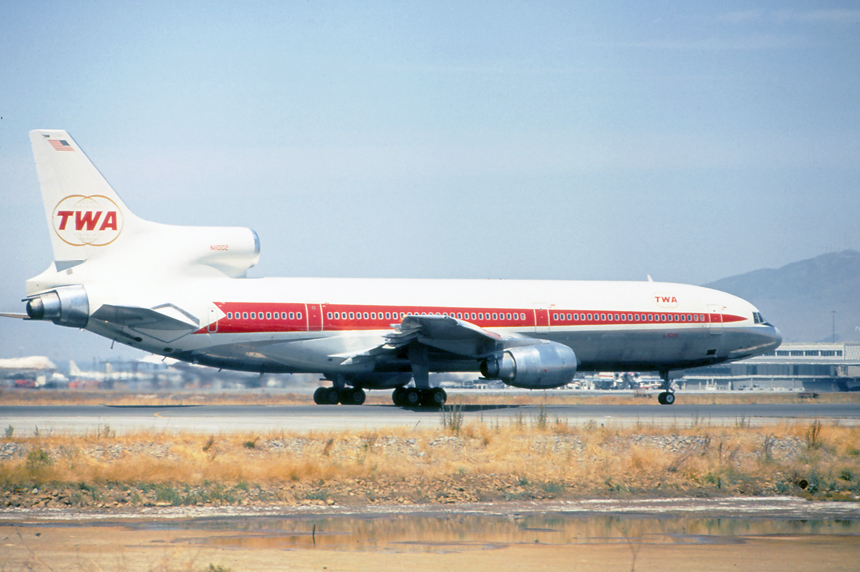
|
September 1973 Trans World Airlines (TWA) and Eastern Airlines were both launch customers of Lockheed's new wide-body passenger jetliner, the L-1011 Tristar. TWA ordered forty-four Tristar's with the first being delivered on May 9, 1972. The plane was to be used for heavy-passenger domestic flights as well as transcontinental routings. As additional aircraft were delivered San Francisco saw the plane introduced in late 1972 on flights to Boston and Los Angeles. Rolling for takeoff on Runway 01 Right is N11002, a Lockheed L-1011-1, the second Tristar to be delivered to the airline in July 1972. |

|
September 1973 Eager to add capacity and distance to its aircraft roster, QANTAS ordered four of the long-range Boeing 747 "Jumbos" in November 1967. The initial Boeing 747 order was modified to accept Boeing's new higher performance "B" model, the first being delivered on August 16, 1971. Although slated to start trans-Pacific service immediately, legal issues with United States-Australia services delayed the introduction of the plane on the famous "Southern Cross" route. With legal proceedings resolved, Sydney to San Francisco service via Honolulu and Nadi using the Boeing 747 commenced on January 29, 1972. Rolling for take-off on Runway 1 Right is VH-EBC "City of Sydney," a Boeing 747-238B delivered to the airline on October 22, 1971. |

|
September 1973 By 1973, San Francisco had become a popular destination for Delta Airlines on flights from the carriers "hubs" at both Atlanta and Dallas-Ft. Worth. The Douglas DC-8 continued to provide the aircraft choice on the two routes, however the use of the new Lockheed L-1011 as well as the Boeing 747 supplemented the flights based on passenger loads. Holding in position for takeoff on Runway 1 Right for a mid-day departure is N823E, a Douglas DC-8-61, delivered new to the airline in June 1967. |

| October
1973 TWA was an early airline to order Boeing’s new “Queen of the Skies," Boeing 747 with initial orders for nineteen of the "Jumbos" in 1967. TWA received its first 342-passenger Boeing 747 on December 31, 1969. On February 25, 1970, TWA became the first US airline to put the 747 on domestic services when flights were inaugurated between New York-JFK and Los Angeles (Pan Am was the first airline to operate the 747 a month earlier however it was placed on the prestigious New York-London route). Complete with a sixteen passenger upper deck lounge, the new 747 were the epitome of TWA’s “Royal Ambassador” service. Wide-body Boeing 747 service started to San Francisco two months later on April 5, 1970, when non-stop New York flights were added to the schedule. Over the next year, TWA flights to both Chicago and Washington Dulles from San Francisco had service added using the Boeing 747. Lining up on Runway 1 Right for an afternoon departure and wearing the famous “Twin Globes” logo is N93113, a Boeing 747-131 delivered new to TWA on October 22, 1970. |

| October 1974 As San Francisco's first international airline, Japan Airlines, also made history as being the first international airline to start all-cargo service into the airport as well. Seeing a freight and cargo market as lucrative as passengers, Japan Airlines formed the all cargo division of the airline in 1959, and started cargo only flights into San Francisco in May of that year using a Douglas DC-6C. When its first jet freighter Douglas DC-8 entered service on October 17, 1967, San Francisco was host to the first services. As the cargo market continued to grow, the airline placed an order for the all freight version of the Boeing 747. The first plane was delivered in 1974, and immediately put into service on the biggest cargo markets such as London, Los Angeles and San Francisco. Having just arrived at the cargo ramp during a pleasant fall night is JA8123, a Boeing 747-246F, delivered new to the airline on September 17, 1974. |
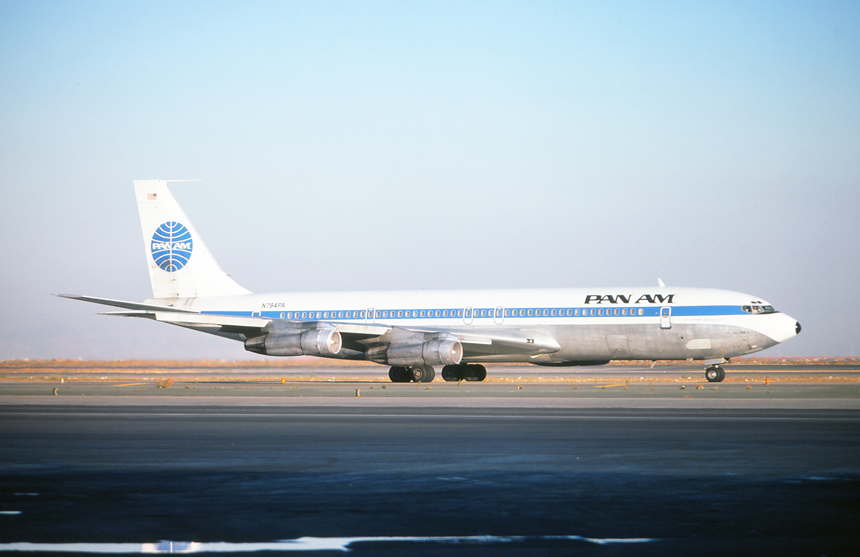
| October 1974 Arguably, the world’s most famous airline, Pan American Airways (Pan Am) made commercial aviation history when it placed an order for twenty of the Boeing 707 airplanes on October 13, 1955. The new four-engined 707 jet transport would launch Boeing into the annuals of commercial aviation along with the leading world airline at the time. Pan American worked extensively with Boeing to design the new transport, including a six-abreast seat layout to effectively compete with the Douglas DC-8. (Or complement, as Pan American also ordered the DC-8). The resulting 707-100 had lower operating costs, increased speed and distance, all of which lowered the seat-mile costs for passengers. Pan American's first Boeing 707 was delivered in August 1958, and they became the first U.S. airline to inaugurate trans-Atlantic jet service on October 16, 1958, between New York and London. Pleased with the Boeing 707s performance and truly a global airline, Pan American ordered and operated one hundred twenty (120) of the Boeing 707-300, the big brother and transcontinental ranged sibling to the venerable 707-100. The series 300 provided the bulk foundation of the Pan American fleet throughout the 1960s and into the 1970s, when it was slowly replaced by the Boeing 747. Taxiing along the Outer Bravo Taxiway and outbound for an evening departure to Honolulu is N794PA “Jet Clipper Undaunted,” a Boeing 707-321C, delivered new to Pan American on April 30, 1964. |

| October 1974 During the mid-1950s, Boeing Aircraft had a vision for a short-to-medium ranged airliner, which could fit between the Boring 707 and smaller 737 product line. The company settled on a narrow-body, tri-jet aircraft with a characteristic high-lift wing. In 1959, Boeing went out to solicit customers, especially with the US “majors.” United Airlines was seeking an aircraft with a range of around 1,500 miles, a capacity of about 120 passengers and the performance ability to operate from close city airports such as New York-La Guardia. Boeing went to work and adjusted their initial proposal a bit, enough that both United Airlines and Eastern Airlines became launch customers in 1960, for the Boeing 727 with twenty firm orders each (as well as an additional twenty options each). United’s first 727 was delivered on October 29, 1963, with passenger flights starting on February 6, 1964, between San Francisco, Salt Lake City, and Denver. United would eventually operate over 140, Boeing 727 airplanes which made up the bulk of its short-to-medium ranged flight throughout the 1970s and 1980s. Caught taxiing along the Outer Taxiway Bravo en route to the Runway 01 Left for an early evening departure is N7407U, a Boeing 727-22C, delivered new to United in September 1966. |

|
November 1974 Pacific Southwest Airlines (PSA) made a historic move in 1970, when the intra-state carrier purchased two Lockheed L-1011 “wide-bodies” with an option for three more. The philosophy behind the purchase was limited gate space which effectively reduced passenger capacity on its most popular “California Corridor” Los Angeles-San Francisco route. The new L-1011s would be able to carry up to 302 passengers and solve the gate availability problem. Wearing an updated tri-color pink, orange and red cheat line, the airlines first L-1011 was delivered in July 1974, and placed into service on October 18, 1974 (after a world-wide tour with Lockheed). Although initially placed on the popular Los Angeles-San Francisco route, the L-1011s were planned to be used in other PSA cities such as San Diego, Sacramento and Burbank (yes Burbank!). Unfortunately, the planes arrived at a difficult time when fuel costs were soaring and a decline in air travel was abound due to a worsening economy. After only a few months in service, the L-1011s were parked in the desert, with the hope of being reintroduced when the economy turned positive. This never happened and the PSA L-1011s were eventually disposed of. The “big and small” of the PSA fleet is shown on a busy ramp while parked at the Central Terminal are N380PS, a Boeing 737-214 and N10112, a Lockheed L-1011-1 Tristar. |

| December
1974 A rather unique visitor to San Francisco during the mid-1970s was a Yugoslavia Airlines Boeing 707 on a "around-the-world" tour flight. The national airline of Yugoslavia, Jugoslovinski Aero Transport (JAT) started operations in 1927. The airline maintained operations in the European region until 1970, when a Boeing 707 was purchased for intercontinental operations. The airline used the new plane for a variety of charter flights and "around-the-world" tours. One such tour started eastbound from Beograd, Yugoslavia to ten cities on three continents. San Francisco was a location on itinerary between the stops of Honolulu, Hawaii and New York City. Seen taxiing outbound for takeoff after a short stop in the Golden Gate City is YU-AGA, a Boeing 707-321, originally delivered to Pan American Airlines in October 1959. |

|
April 1975 Vancouver, Canada based CP Air typically used the Boeing 737 on its three daily departures to Vancouver. On occasion, the airline used its Douglas DC-8s on the single city routing, as the longer-range "8s" were normally used on international and trans-Canadian flights. Seen taxiing outbound for takeoff is CF-CPM "Empress of Lisbon," a Douglas DC-8-53, delivered to the airline in May 1966. |

|
May 1975 In 1975, Braniff International Airways continued to serve San Francisco with only one route to Los Angeles with continuing same plane service to Lima, Peru. The flight was operated only three times a week and once during those days using a Douglas DC-8. Seen climbing out during a evening departure to LAX is Braniff Flight 921, N1803, a Douglas DC-8-62, wearing the "green" Flying Colors scheme. |
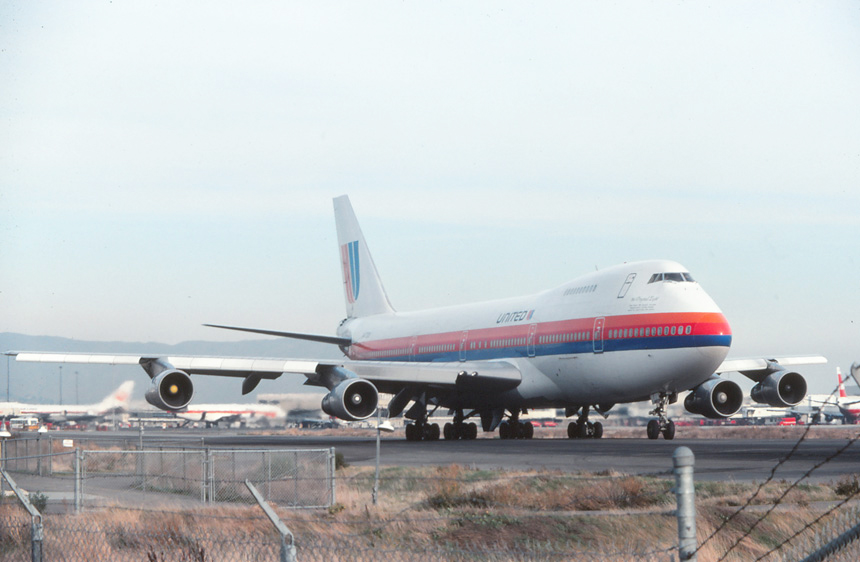
|
January 1976 San Francisco was an early city added by United Airlines predecessor carrier, Pacific Air Transport's multi-stop, Pacific Coast route between San Diego and Seattle. United would eventually establish San Francisco as a hub of operations, especially with flights to Hawaii, started in the mid-1950s. United introduced the new Boeing 747 "Jumbo Jet" on both transcontinental and Hawaii services in 1970. San Francisco saw the new Jumbo's placed on routes to Chicago, Boston and Honolulu during the early 1970s. Approaching Runway 1 Right for a morning departure is N4712U, a Boeing 747-122 named "The Original Eight" to commemorate the original eight flight attendants hired by United Airlines in the 1930s. |

|
February 1976 As a gateway city for American Airlines, especially on trans-continental services, the airlines "wide-body" Douglas DC-10 "Luxury Liners" with a capacity of 259-passngers were seen on services from San Francisco to Chicago-O'Hare, Dallas-Ft. Worth, and New York-JFK. Seen taxiing inbound toward the gate at Pier B after having landed is N102AA, a Douglas DC-10-10. |

|
February 1976 Although Orange County based Air California started operations in 1967 using the Lockheed L-188 Electra, they were quickly replaced with Boeing 737 "jet" aircraft by 1971. Air California was granted permission to start service to South Lake Tahoe Airport in 1975, and with the mountain based airport having a ban on pure jet aircraft operations, the airline re-acquired the venerable Lockheed Electra for Tahoe services. Seen preparing to depart the terminal area for a mid-day flight is N124AC, a Lockheed L-188 Electra-A, acquired by the airline in April 1975, and re-registered a few months later on June 17, 1975. |

|
February 1976 The Boeing 737-200 continued to be the aircraft of choice for intra-state carrier Air California and by 1976, was flying eight of the type. San Francisco had numerous daily flights to Oakland, Santa Ana-Orange County, and Palm Springs. Seen taxiing along the inner apron after having landed toward Pier D is N468AC, a Boeing 737-293, delivered new to the airline in September 1970. |

|
February 1976 United Air Lines established its Air Freight division on December 23, 1940 using a Douglas DC-4 on mail service between New York and Chicago and becoming the first U.S. airline to start an all cargo service. United's air freight business grew enough that the airline ordered fifteen of the Douglas DC-8-54AF or All Freight configuration with no windows and placing the first in service in February 1964. San Francisco was considered a large air freight hub for the airline, with daily departures to no less then eight destinations including Honolulu, Denver, Cleveland, and Chicago. Seen taxiing along the inner apron for an afternoon departure is N8050U, a Douglas DC-8-54AF, delivered new to the airline in March 1968. |

|
July 1976 Pacific Southwest Airlines PSA, continued to be a popular intra-state carrier with its catchy slogans, "hot-pantsed" flight attendants, and "hot-pink" color schemes. Although the airline was based in San Diego, San Francisco was considered a focus city with multiple daily departures to seven California cities including hourly daily departures to Los Angeles. Seen taxiing outbound from the terminal for an afternoon departure as a Trans World Airlines TWA Boeing 707 climbs away from Runway 1 Left is N544PS, a Boeing 727-214, delivered new to the airline in September 1970. |

|
July 1976 The Douglas DC-8 series continued to be used by United Air Lines on both domestic and trans-Pacific services. The "stretch" series -60 was used on flights to Hawaii as well as trans-continental routings while the shorter, series -11/-21/-51 were used on short to medium range segments on the airlines route map. Although showing a bit of its age by 1976, with many of the original delivered Douglas DC-8s reaching seventeen years in service, they were still being used on hundreds of flights daily including from San Francisco to Chicago, Los Angeles, Oakland, Sacramento, and Hilo, Hawaii. Seen taxiing away from the terminal for an afternoon departure is N8967U "Harold Crary," a Douglas DC-8-62H, named after a pioneering sales Vice President for the airline. |
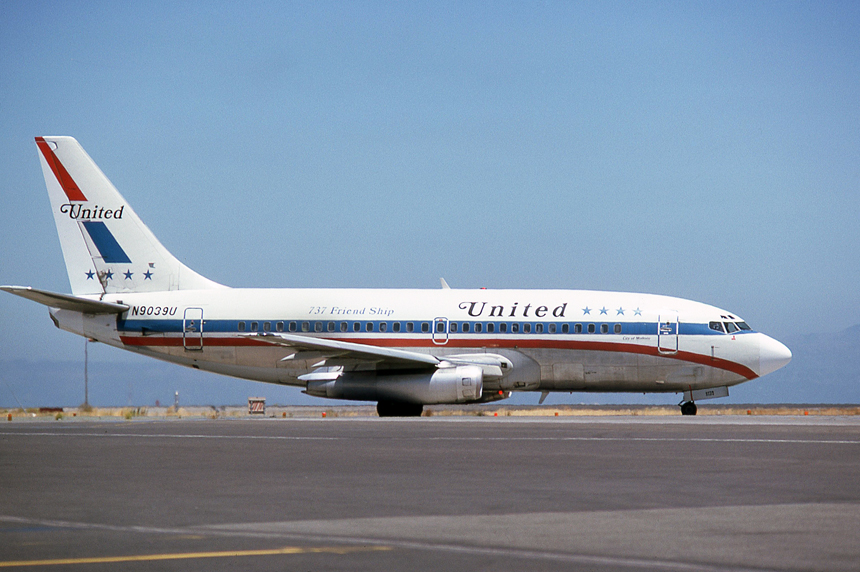
|
July 1976 San The Boeing 737 continued to be the choice for short haul or intra-state routes for United Air Lines especially the San Francisco market where by 1976, no less then twenty daily departures utilized the 737 on flights to destinations including Eugene, Fresno, Stockton, and Monterey. Seen taxiing along the inner apron enroute to Runway 1 Left for an afternoon departure is N9039U "City of Modesto," a Boeing 737-222, delivered new to the airline in November 1968. |
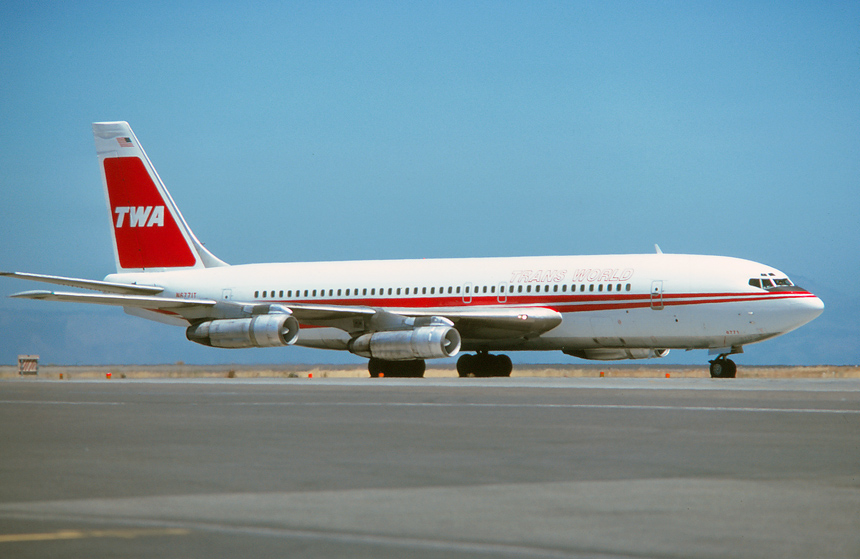
| July 1976 Trans World Airlines (TWA) introduced a new colors scheme in 1976, that replaced the "Star Stream" colors introduced in the early 1960s. The new, bold livery included two, bold red fuselage stripes and a red tail embossed with the TWA script. Over the next few years the "classic" colors were replaced by the new design and aircraft from the Boeing 727 to the 747 were repainted in the colors to take the airline into the next decade. Having been freshly painted and taxiing along the "inner" apron is N6771T, a Boeing 707-131B, delivered new to TWA on May 27, 1967. |

|
September 1976 American Airlines introduced the Boeing 727 in 1964 as an addition to it's fleet of Boeing 707s on short to medium range routes. San Francisco saw the airlines Boeing 727 placed on routes in the early 1970s on medium range routes to Dallas-Ft. Worth, Oklahoma City, and Phoenix. Having just been pushed back away from the gate at Pier E, and reflecting nicely in the afternoon sunlight is N843AA, a Boeing 727-223, delivered to the airline just a year earlier in May 1975. |

|
October 1976 Many of the major U.S. airlines placed orders in the late 1960s for the "Queen of the Skies" Boeing 747 to be used on popular, heavily traveled routes. Each airline advertised specific luxuries or amenities on their new "Jumbo Jets," and American was no exception. With an early fleet of sixteen 747s, American's had a capacity of 361 passengers complete with a coach lounge, and first class lounge complete with electric piano. San Francisco was a major market and American's Boeing 747s were used on twice daily services to New York-JFK. Seen taxiing away from the terminal for an early evening departure to the "Big Apple" is N9664, a Boeing 747-123. |

|
January 1977 United Airlines pleased with their earlier Douglas DC-8 product became the launch customer for the "Super" DC-8 series -61 with additional fuselage space in front of and behind the wings resulting in increased passenger capacity and extended wings enhancing range. At the time of its production in 1967, it was considered the longest airliner at the time. United received its first Douglas DC-8-61 on February 24, 1967 and the aircraft with a capacity of 198 passengers was initially placed on California to Hawaii services followed by heavier trans-continental routes. Seen being pushed back from the gate at Pier C and wearing the "new" Saul Bass colors is N8088U a Douglas DC-8-61, delivered to the airline in July 1968. |

|
March 1977 Jet Set Travel Club was a member based private travel club based at Boeing Field, Seattle, Washington. Jet Set was founded in 1970 to provide members with scheduled flights to fixed destinations, booked on a first-come-first-serve basis. The club received it's first aircraft, an ex-United Airlines Boeing 720 in June 1971, with flights starting a month later. Parked and secured at the western cargo ramp during a member scheduled flight, is N7225U, a Boeing 720-022, originally with United Airlines. |

|
May 1977 Even the aging Douglas DC-8-50 fleet operated by United Airlines continued to provide reliable service for the airline and was updated in the new corporate colors as evidence by N8035U, a Douglas DC-8-52, being pushed back from Pier C and delivered to the airline in May 1961. The size difference between the two DC-8 series -52 and -61 airframes is evident by comparing the previous picture in January 1977 with this one. |

|
May 1977 A panoramic view of Pier D showing Hughes Airwest's three gates and a pair of their DC-9s; N9359 and N9352, both Douglas DC-9-15RCs and a Pacific Southwest Airlines (PSA) Boeing 727 being serviced for their next flights. |

|
May 1977 Trans World Airlines (TWA) was an early operator of the Boeing 727 ordering the type in 1963 to eventually replace the Lockheed Constellations and provide jet service on short to medium range routes. The first 727 was placed into service for the airline on June 1, 1964 between New York-JFK and Indianapolis, Indiana. TWA started service with the 727 into San Francisco during 1966 on flights to Kansas City. By 1977, TWA was using the 727 from San Francisco to Denver, Las Vegas, Phoenix, and Tucson. Seen taxiing away from the terminal complex for an early evening departure is N64324, a Boeing 727-231, delivered new on July, 2, 1969. |
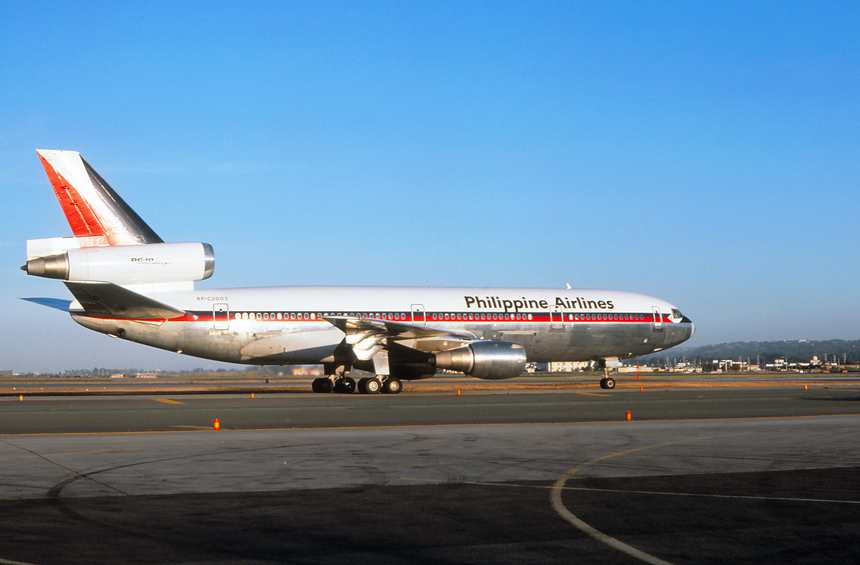
| May 1977 The national airline of the Philippines, Philippine Airlines started operations in 1941, to provide air transport services to the Philippine Islands. The airline evolved quickly and started its first charter service to the United States via Guam, Wake Island, Honolulu, and San Francisco in 1946. Regular trans-Pacific flights started in December 1946, using a Douglas DC-6 Pacemaker. Philippine Airlines ushered in the jet age with the introduction of the Douglas DC-8 in 1962, followed by the "wide-body" Douglas DC-10 in July 1974. The new DC-10 tri-jet was placed on the popular, daily Manila-Honolulu-San Francisco route providing service on the same pioneering route started almost thirty years early. Taxiing outbound for an evening departure to Honolulu and continuing on to Manila is RP-C2003, a Douglas DC-10-30, delivered new to Philippine Airlines on October 22, 1976. |
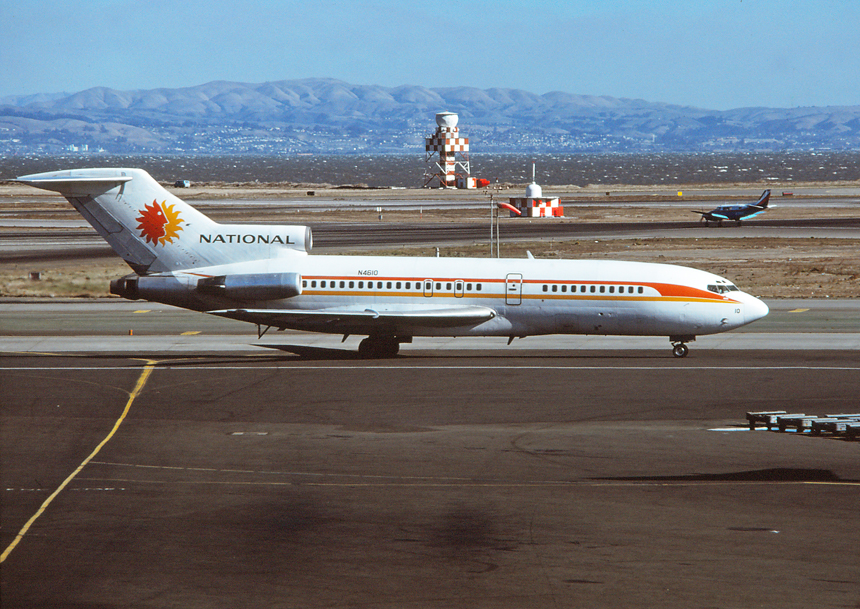
|
May 1977 National Airlines was finally able to go "national" in 1961, after the Civil Aeronautics Board (CAB)approved the Southern Transcontinental Route case which gave National Airlines rights to start flights to California from various southern destinations. New flights were started on June 11, 1961, from San Francisco to Houston, New Orleans, Miami and Las Vegas with Douglas DC-8 and Lockheed Electra aircraft. Pure "Jet" 727 flights were started in 1965, to the West Coast on the San Francisco-Houston and San Francisco-Las Vegas routes. Throughout the 1970s, National Airlines Boeing 727s were used on short and medium range flights throughout its route network. Taxiing along the "inner" apron en-route to its gate is at the Central Terminal is N4610, a Boeing 727-35, originally delivered new to National Airlines in October 1964. |

| June 1977 Although the Boeing 720s operated by Western Airlines had been in service for over 15 years, they were still used on popular flights between West Coast coast city pairs such as San Francisco-Anchorage, San Francisco-San Diego, and Los Angeles-Seattle. Seen taxiing away from the terminal toward the active runway for departure is N93149, a Boeing 720-047B, originally delivered to the airline in April 1963. |
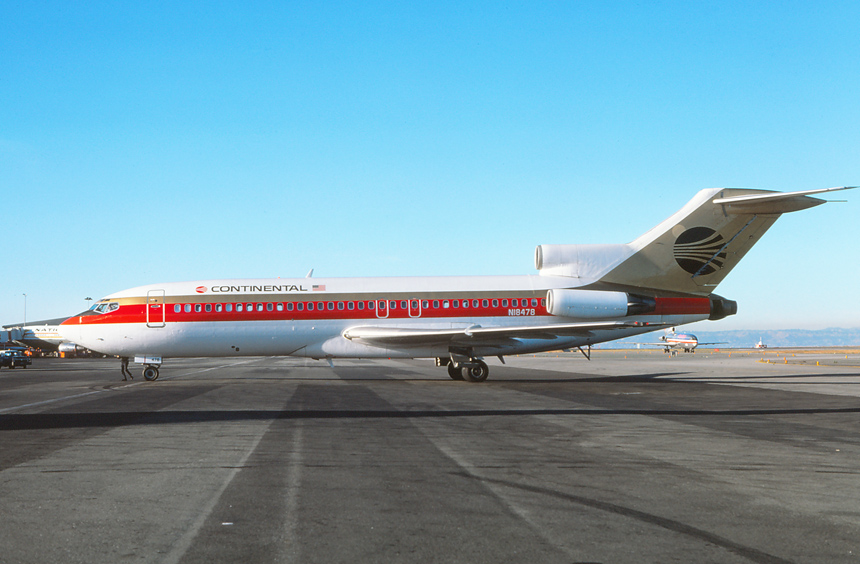
| June 1977 As part of Continental Airlines Civil Aeronautics Board (CAB) ruling on routes between the Pacific Northwest and Southern California, the airline also received route authority for flights between San Francisco and Albuquerque in 1970. The airline within a few years added services to both Portland and Seattle maintaining these routes until deregulation in 1978, when flights were added to El Paso and eventually Houston. Having just been pushed back from the gate for an early evening departure is N18478, a Boeing 727-30, delivered new to the airline in March 1976. |

|
June 1977 San Francisco was one of only two cities that Vancouver, Canada based CP Air was authorized to serve in the United States with scheduled flights. The airline had been providing flights to San Francisco since 1967, using the Boeing 737 on the short 800-mile "hop" north. CP Air also operated the Douglas DC-8-60 series on longer flights from Canada across the Pacific, to South America and Europe and on occasion were substituted for the traditional 737 on flights to the Bay Area especially during the busier summer months. Seen taxiing out for a late afternoon departure is CF-CPS "Empress of Madrid," a Douglas DC-8-63. |

|
June 1977 Delta Airlines started operations with the Boeing 727 after the airline acquired twenty-one of the type during the Northeast Airline merger in August 1972. Delta would eventually place orders for the Boeing 727 "advanced stretch" series -200 in 1972 to be used on short and medium range routes especially along the Eastern Seaboard and eventually replacing the Convair CV-880 and certain Douglas DC-8s. San Francisco saw Delta's Boeing 727 introduced in 1976 as additional capacity on flights to Dallas-Ft. Worth. Seen taxiing out for an afternoon departure is N498DA, a Boeing 727-232, delivered new to the airline in August 1975. |
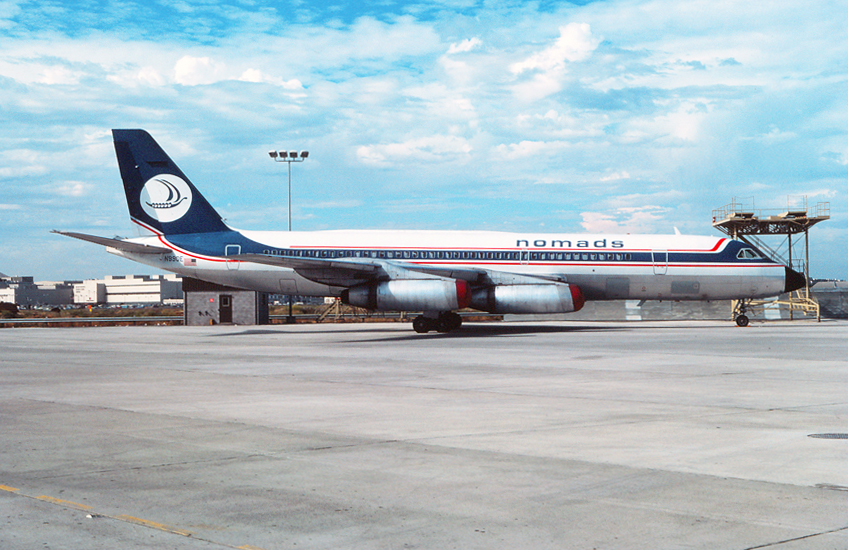
| July 1977 Detroit based travel club Nomads was established in 1965, to provide its members an alternative to commercial airlines in a "club" type atmosphere. Nomads first airplane was a Douglas DC-4 and this was replaced in 1971 with a Lockheed Electra Turboprop. With additional members joining the club and trips being scheduled to world-wide destinations, Nomads sought to increase capacity, distance and speed and purchased a Convair 990. The "Coronado" would be the primary aircraft used for both long and short charter flights as part of the travel clubs various tour offerings until being replaced by a Boeing 727 in 1981. Parked and secured at the western cargo ramp during a charter flight to the bay area is N990E, a Convair 990-30A-5, originally delivered to American Airlines in 1962, and subsequently purchased by Nomads in August 1975. |

| August
1977 San Luis Obispo based Swift Aire was an early commuter airline having started flights in March 1969, from San Luis Obispo to both San Francisco and Sacramento using a Piper Navajo. As the small commuter grew it needed an aircraft to compete with the larger carriers and decided on purchasing three of the unique Nord 262 turboprop aircraft. The new planes were delivered in 1977 and placed on trunk routes such as flights to San Francisco. Swift Aire continued to serve San Francisco from San Luis Obispo, Modesto, and San Jose until its purchase by Golden Gate Airlines in 1982. Taxiing out for departure is N419SA, an Aerospatiale Nord 262A-12. |

| August 1977 One of the many local commuter airlines to be established in the Bay Area during the 1970s was STOL Air which started operations in 1972. The intra-state airline was based at San Francisco and provided flights to destinations in Northern California such as Concord, Napa, and Santa Rosa using a unique fleet of Britten-Norman Islander turboprop aircraft. With the departure of Golden West Airlines from the Bay Area market after buying Sacramento based Skymark Airlines, STOL purchased the routes from Golden West and continued to provide the local services. Departing the Central Terminal for another commuter flight and showing its size in comparison to a neighboring American Airlines 747, is N403JA, a Britten-Norman BN-2A Mark III Trislander. |
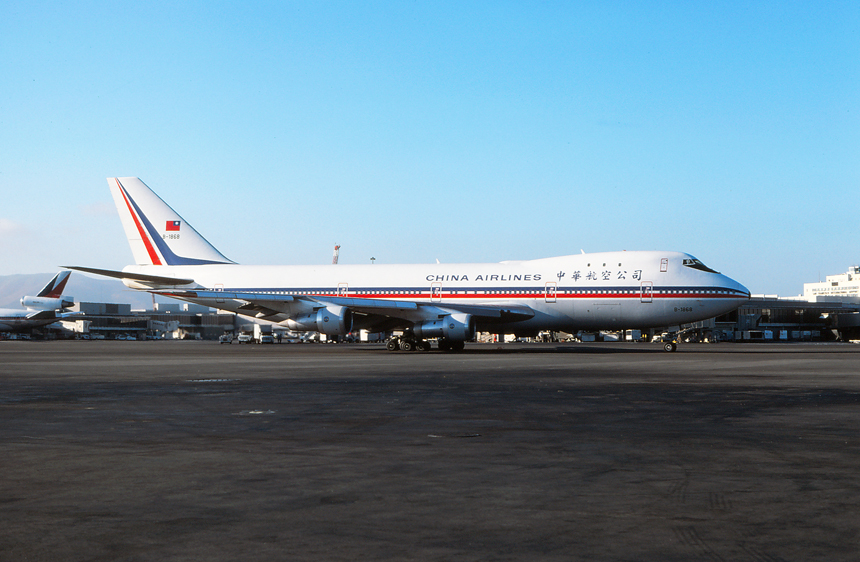
|
August 1977 With the growth of the Asian market continuing especially with the growth of the electronics and consumer markets in Taiwan, China Airlines leased two Boeing 747s for increased passenger and cargo capacities in the trans-Pacific market. The 747 was introduced on the airlines flagship Hong Kong-Taipei-Tokyo-Honolulu-San Francisco route in June 1976. Having just been pushed back from Rotunda A and awaiting taxi clearance for an evening departure is B-1824, a Boeing 747-132, originally with Delta Airlines and delivered to China Airlines in June 1976. |
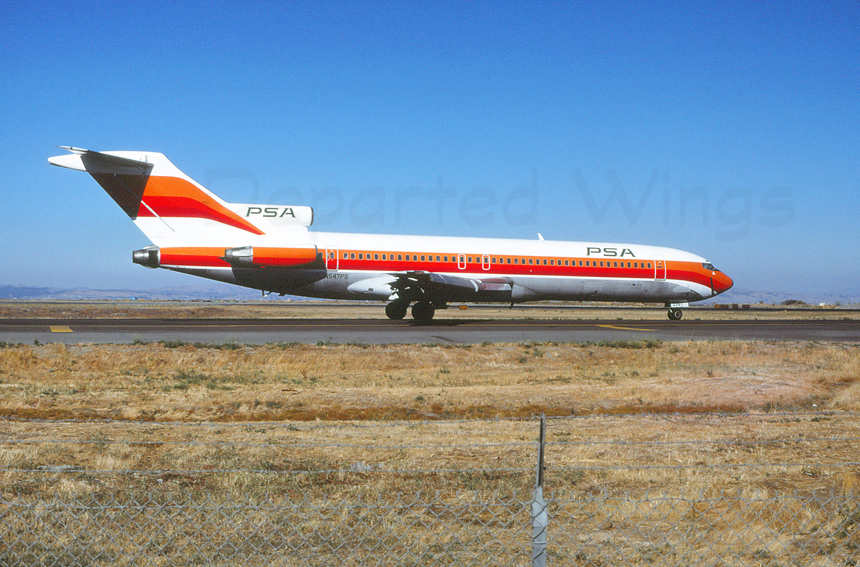
|
August 1977 United During 1977, Pacific Southwest Airlines (PSA) modified its "hot pink" tri-color stripes to the bold but more subtle red, red-orange, and orange colors. The new image would take the airline into the decade of the 1980s as a well recognized intra-state carrier. Seen taxiing to Runway 1 Right for a late afternoon departure on a warm summer day is N547PS, a Boeing 727-254, delivered new to PSA on December 12, 1969. |

|
August 1977 With a capacity of 302-passengers in a two-class domestic configuration, Delta Airlines Lockheed L-1011s were used on the thrice daily services to Atlanta, as well as flights to Los Angeles. Taxiing toward Runway 1 Right for an afternoon departure is N710DA, a Lockheed L-1011-385-1 Tristar. |

|
August 1977 When National received its first Douglas DC-10 in 1971, the plane was used on the trunk transcontinental routes such as on services from San Francisco to Miami and Houston. By 1978, National was serving San Francisco from Los Angeles, Las Vegas, Houston, Miami, and New Orleans using Boeing 727 or DC-10s as loads required. The DC-10s were especially popular on the transcontinental route to Miami with deep discount fares and the notable "Sun King" in-flight services. Taxiing out to Runway 1 Right for an afternoon departure is N61NA "Dinah," a Douglas DC-10-10. |

| January 1978 Still wearing the "Friend Ship" color scheme introduced in 1972, with the four stars, representing "four star service," N1820U, a Douglas DC-10-10 taxis along Taxiway Alpha on a cold winter morning. |

| January 1978 By In 1977, Pacific Southwest Airlines (PSA) reacquired the Lockheed L-188 Electra turboprop for scheduled services to the mountain resort of Lake Tahoe. PSA had phased out the Electra in 1967 when it became an all-jet fleet, however with the approval of service to Lake Tahoe the Electra became key for operations to the airport that had a ban on jet flights. Initially using two Lockheed Electra's, service was started in 1975 to Lake Tahoe from both Los Angeles and San Francisco Taxiing out for a early evening departure is N6118A, a Lockheed L-188 Electra-A. |
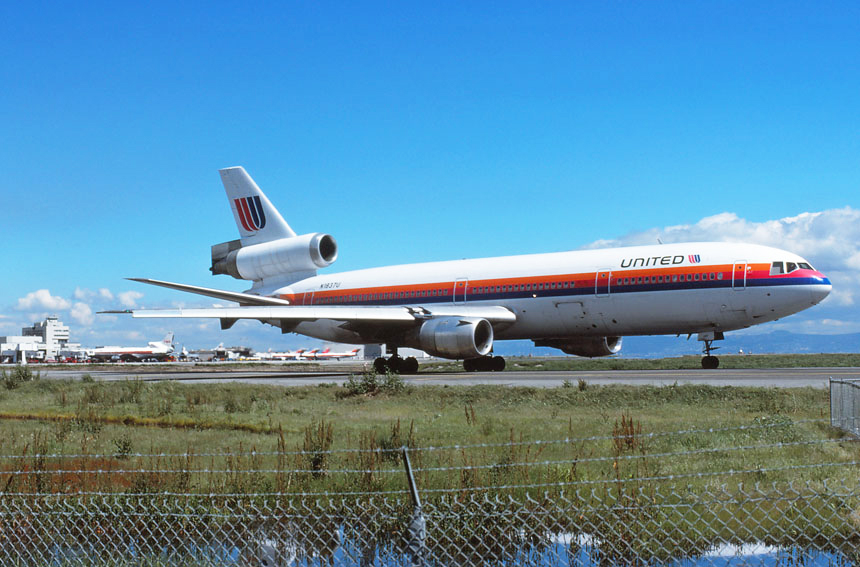
| April 1978 By 1978, United Airlines had placed the Douglas DC-10 on routes from San Francisco to Boston, Chicago, Hilo, New York (JFK), Newark, and Washington Dulles. The Douglas Tri-Jet had become the flagship on trans-continental and trans-Pacific routings for the airline. Taxiing to Runway 01 Right for a afternoon departure is N1837U, a Douglas DC-10-10. |

| April 1978 The Boeing 727 series made up the bulk of the United Airlines fleet in the late 1970s. In 1978, United served no less then thirty cities from San Francisco with a majority of the destinations such as; Boise, Detroit, Kansas City, Milwaukee, and Reno used the Boeing 727 on the route. Seen taxiing along Taxiway Lima enroute toward Runway 28 Left is N7259U, a Boeing 727-222, delivered just a month earlier to the airline on march 14, 1978. |
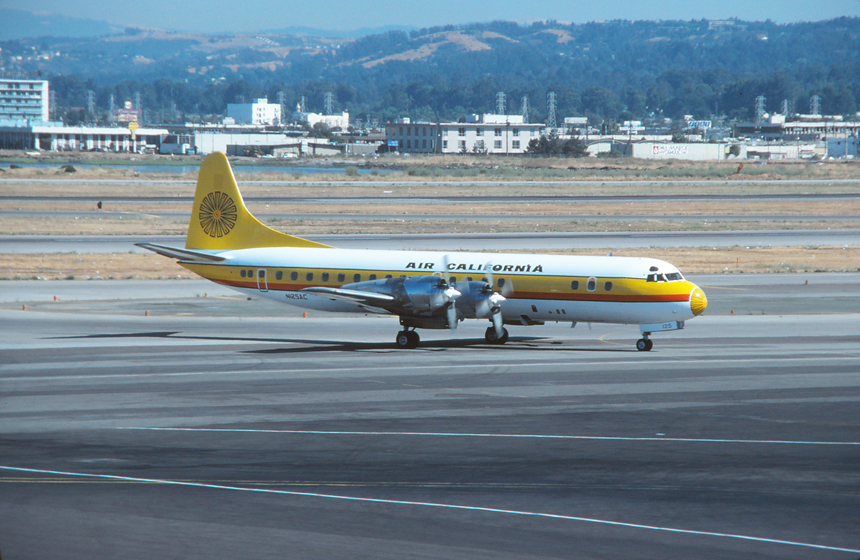
| July 1978 Air California reintroduced the venerable Lockheed L-188 Electra turboprops when the airline started service to the mountain resort of Lake Tahoe located in the Sierra Nevada Mountains. The Electra's were needed to comply with the strict noise restrictions imposed by the city, as well as have the performance necessary for flights into the 6,000 foot elevation airport. Flights were started between San Francisco and Lake Tahoe in February 1975, and proved popular for both summer and winter tourists. Taxiing inbound toward the terminal complex after a flight is N125AC, a Lockheed L-188 Electra-A, originally delivered to General Motors Corporation as a corporate aircraft in 1958, and purchased by Air California in 1977. |

| October 1978 Overseas National Airways (ONA), was a supplemental carrier that provided charter and contract passenger flights especially for the United States military. In 1973, the airline had delivered two new Douglas DC-10s to increase passenger-cargo capacity as well as intercontinental range. ONA would eventually acquire a total of five Douglas DC-10s, before the airline was ceased operations and was liquidated in October 1978. Seen parked on the United Airlines maintenance ramp is N1034F "HolidayLiner Liberty," a Douglas DC-10-30, delivered new to ONA in June 1977, and was then sold to Spantax Spain on October 24, 1978. |
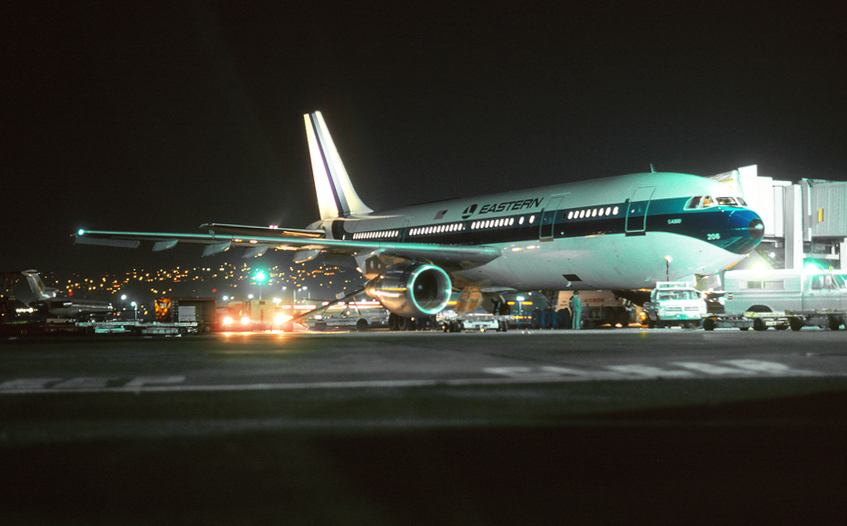
| December 1978 Until the 1970s, the United States held the monopoly on large passenger transport aircraft manufacturing in the free world. During the late 1960s, a consortium of European aviation interests formed Airbus Industries to manufacture and market a twin-engine, large-capacity, short to medium ranged jet airliner. The result was the Airbus A-300, which made its first flight on October 28, 1972, and was delivered to it's first customer, Air France in May 1974. The new Airbus saw decent sales in European and Asian markets, however sales were sluggish in North America. Although Airbus had secured an order in 1976, from Western Airlines, that fell through and Eastern Airlines jumped to a open opportunity. Eastern was looking for an aircraft with low seat-cost-per mile costs and signed a lucrative deal with Airbus to "evaluate" the A-300 during a six-month period. Eastern placed the new wide-body on its "gravy" New York-Miami services in December 1977, and the airline quickly fell in love with the plane. Eastern become the first airline to operate the Airbus A-300 in North America and eventually operated thirty-four of the type, providing the foundation to many of the airlines trunk routes, especially along the East Coast. The Airbuses were also used on transcontinental services from Atlanta and Miami to both Los Angeles and San Francisco. Caught on a busy ramp during a chilly December evening is N206EA, an Airbus A-300-B4-103, originally delivered to Eastern Airlines a month earlier on November 15, 1978. |
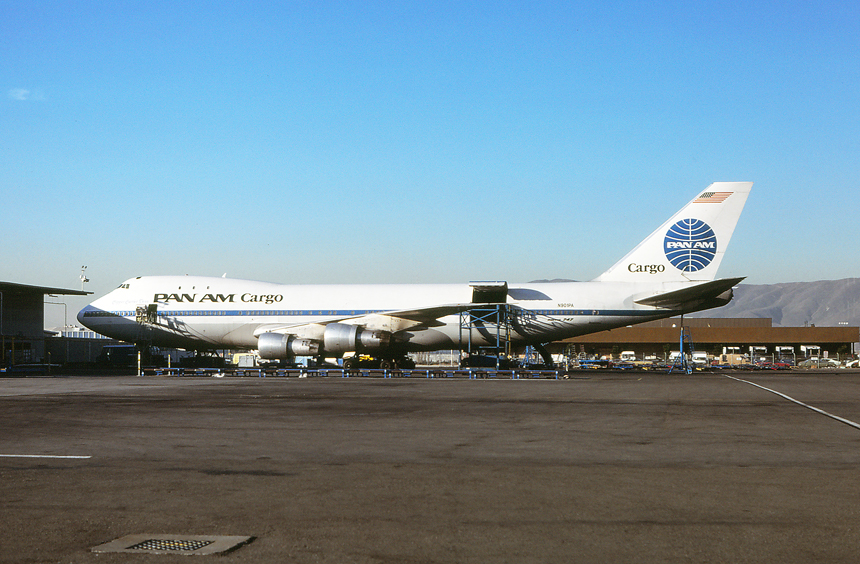
|
December 1978 With such a global presence, famed carrier Pan Am, created an all-cargo division of the airline in 1952. Initial flights used Douglas DC-4, which were followed by Douglas DC-6 freighters for trans-Atlantic cargo service. Eventually "Jet" Cargo service was started with the Boeing 707 in 1963, and in the 1970s Boeing 747 Cargo flights were started world-wide. San Francisco was served with a cargo only flight from Chicago using the Boeing 747s. Pan Am eventually operated four Boeing 747 Freighters until 1983, when the cargo division was dissolved. Parked at the cargo ramp and being unloaded is N901PA, "Clipper Carrier Dove," a Boeing 747-123(F), originally delivered to American Airlines in 1971, and purchased by Pan Am in 1977. |

| March 1979 What started out as a humble air express carrier using a single Dassault Falcon cargo jet in 1972, blossomed into one of the largest overnight package carriers in the Nation. Federal Express built a fleet of the Falcon "miniliners" and in 1978, due to increasing business purchased nine used Boeing 727s to be converted to freighters and used on high-density services. Due to its package volume, San Francisco was one of the first cities to host the Federal Express's trademark purple topped 727s on nightly service to the carriers Memphis hub. Parked at the west cargo ramp and being prepared for accepting cargo for an evening departure is N101FE "Nicole," a Boeing 727-22C, originally delivered to United Airlines in May 1967, then purchased by Federal Express in January 1978, and converted to an all cargo version. |
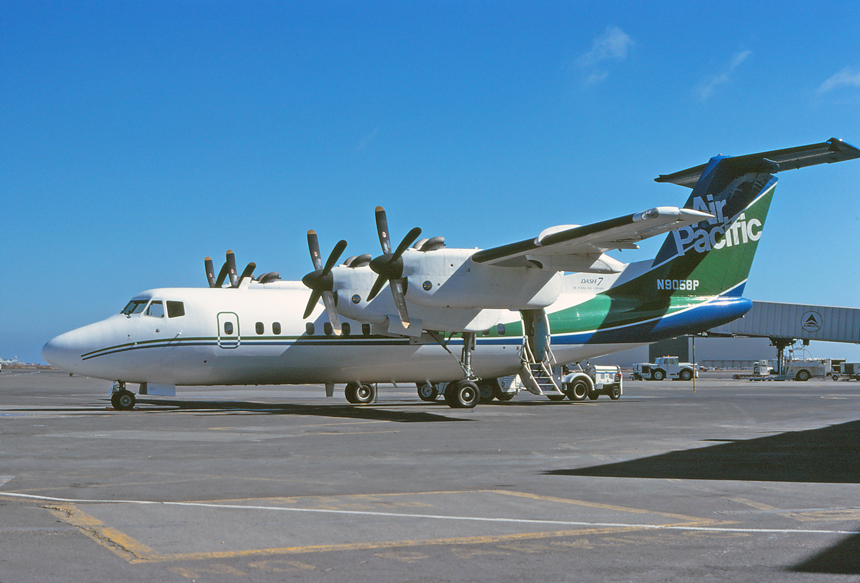
|
September 1979 Air Pacific started as a small air-taxi operator based in Eureka, California and flying under the title Eureka Aero Industries. After the deregulation of the airline industry in 1978, Eureka Aero Industries was purchased and operating model changed to provide commuter service from a San Francisco base using the de Havilland DHC-6 Twin Otter. Within a year the airline ordered two new de Havilland Canada DHC-7 four-engine turboprops for new services to both Bakersfield and Lake Tahoe. Within a few months of starting "Dash 7" service, an investor purchased Air Pacific and merged it with two other airlines renaming the new company as Golden Gate Airlines in 1980. Parked on the Delta Airlines ramp and waiting for its next flight is N9058P, a de Havilland DHC-7-102, and the first example to be delivered to the airline. |
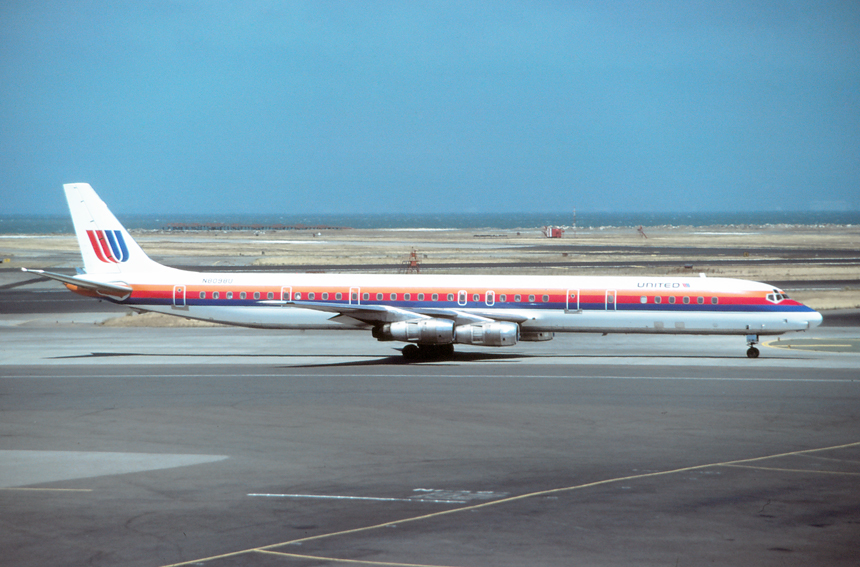
| October
1979 When United Airlines placed an order for thirty of the new Douglas DC-8 jets in October 1955, they became the first US airline to place an order for pure jet aircraft. United received its first DC-8 "Mainliner" on June 3, 1959, and services were inaugurated between San Francisco and New York-Idyllwild on September 18, 1959. United eventually ordered the stretch version of the Douglas DC-8, the series-61, for use on trans-Pacific Hawaii services as well as popular long-distance domestic routes. With deliveries starting in 1967, the new 198-passenger capacity turbojet was initially placed on the San Francisco-Honolulu services. Taxiing along Taxiway Alpha outbound for takeoff and wearing the Saul Bass colors introduced in 1974, is N8098U, a Douglas DC-8-61, delivered new to the airline in June 1969. |
Back to: The Airports